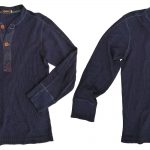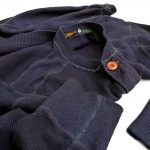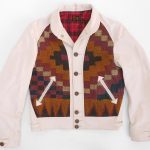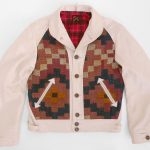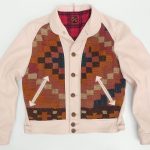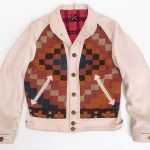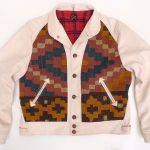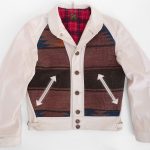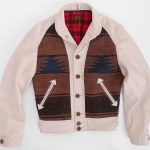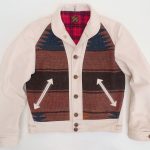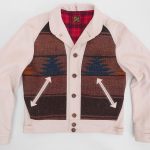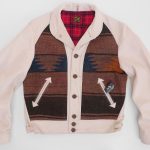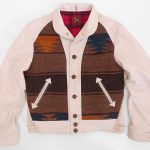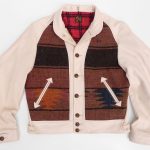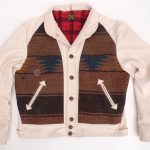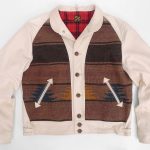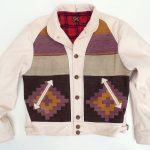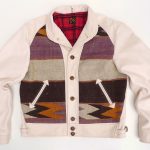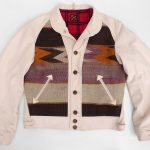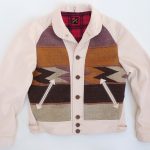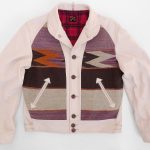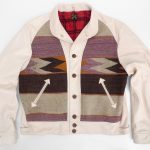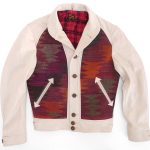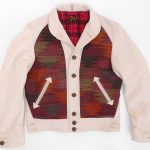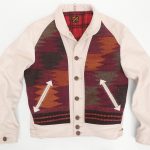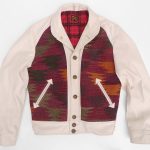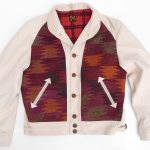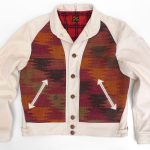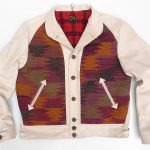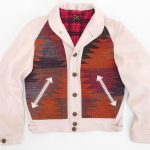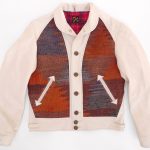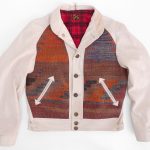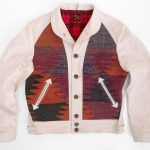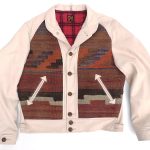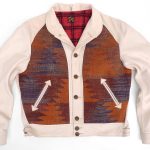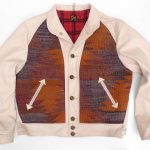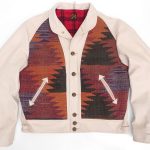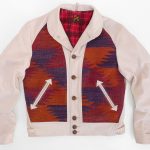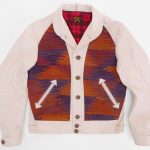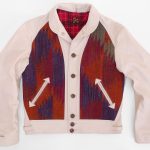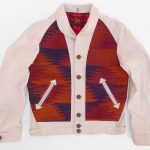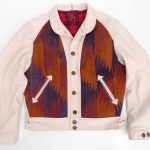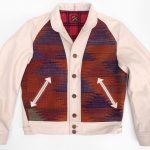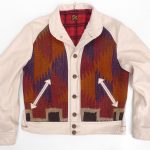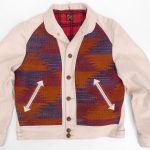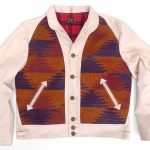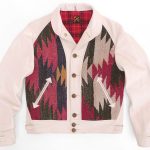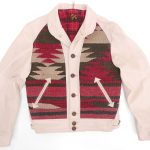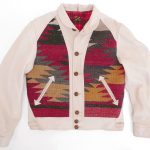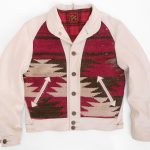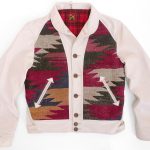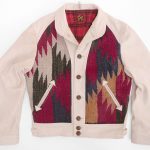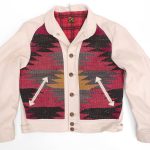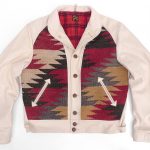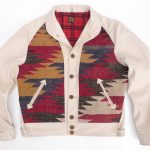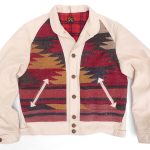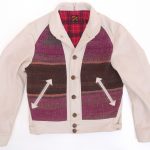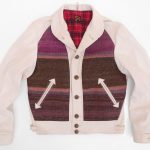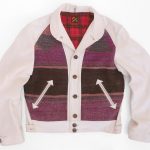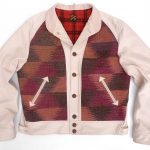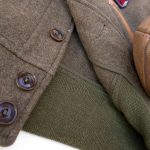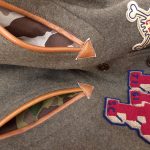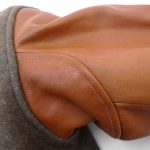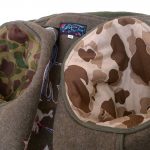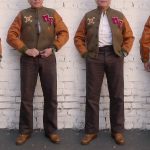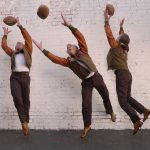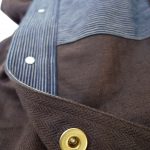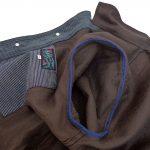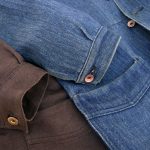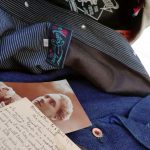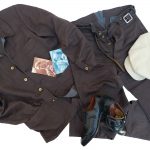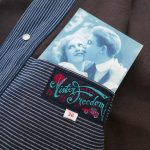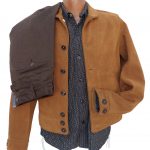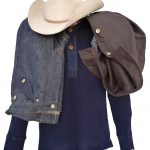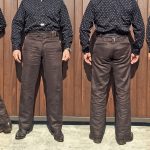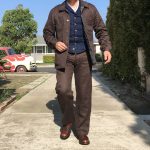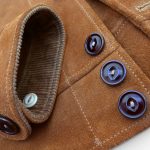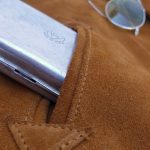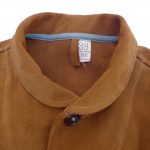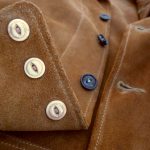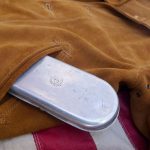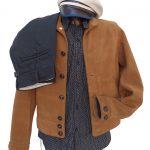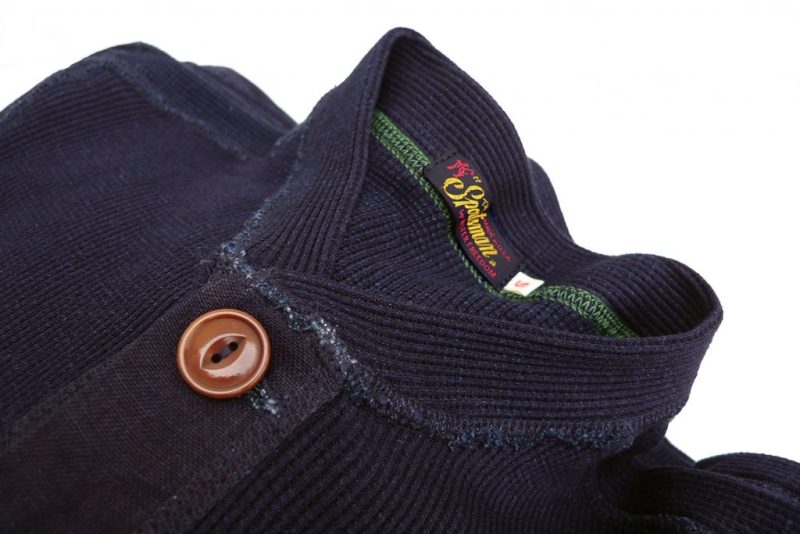

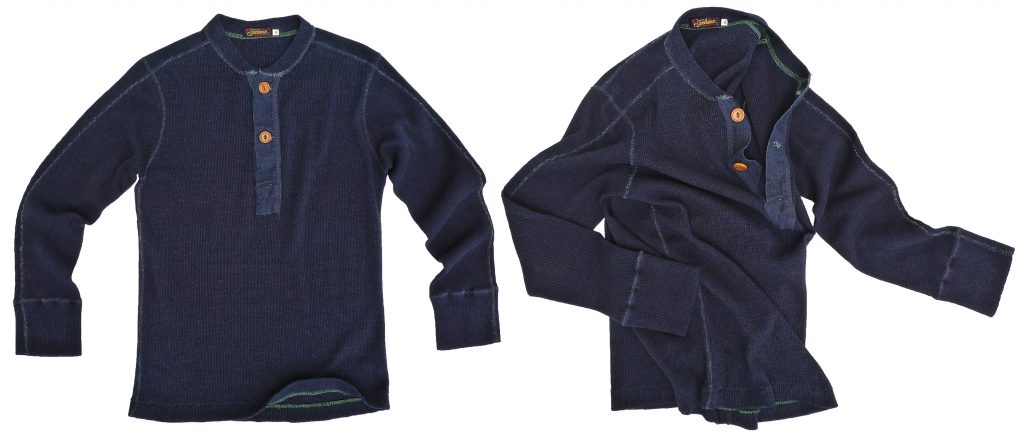
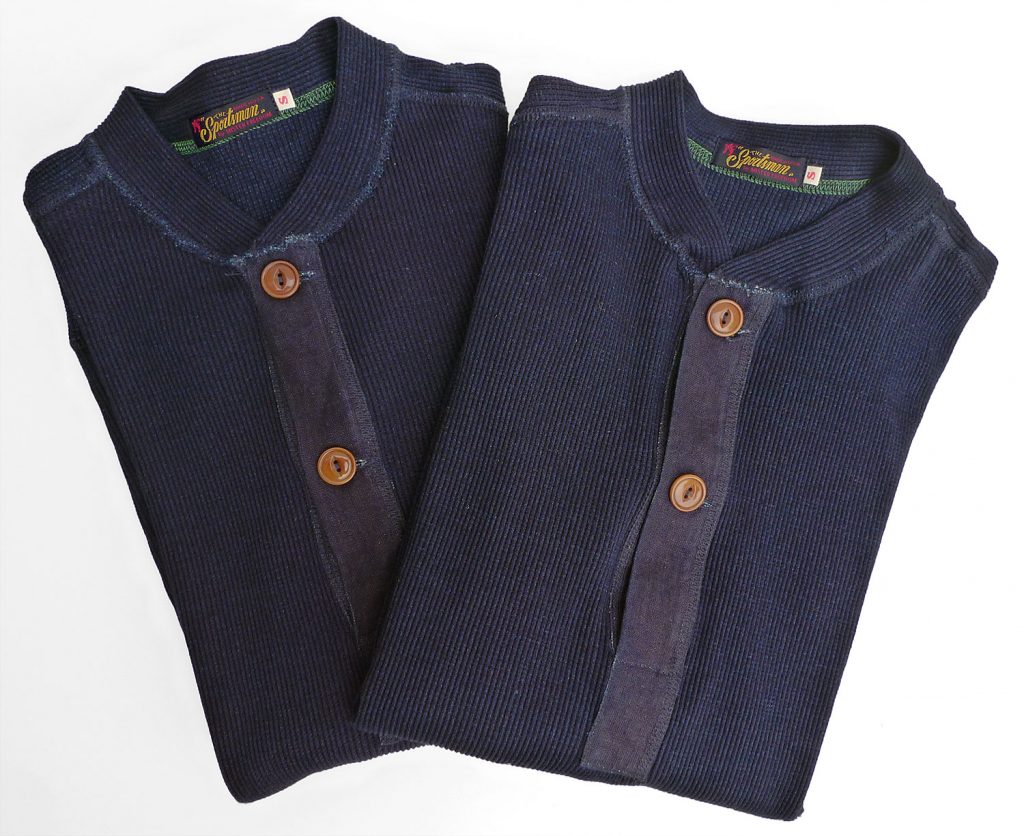
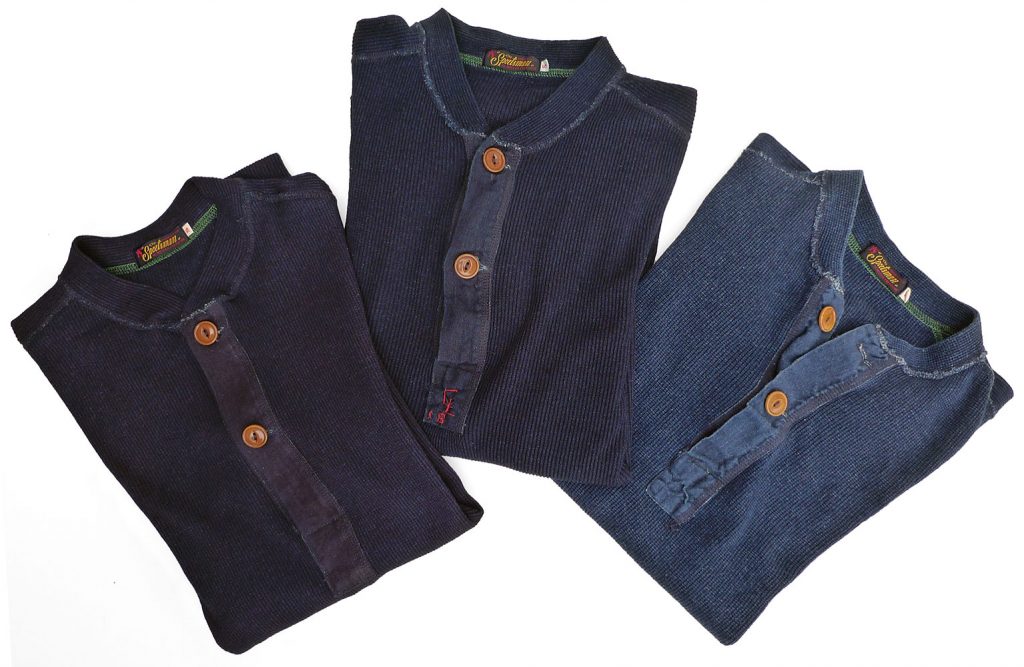
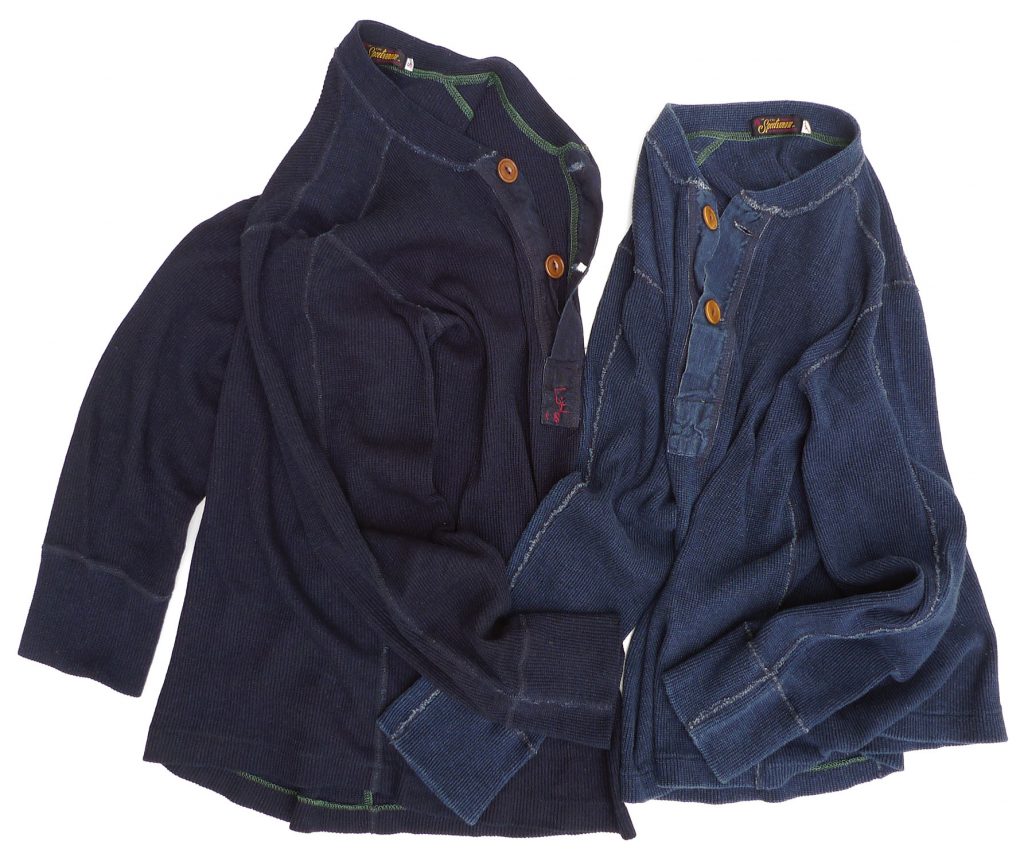
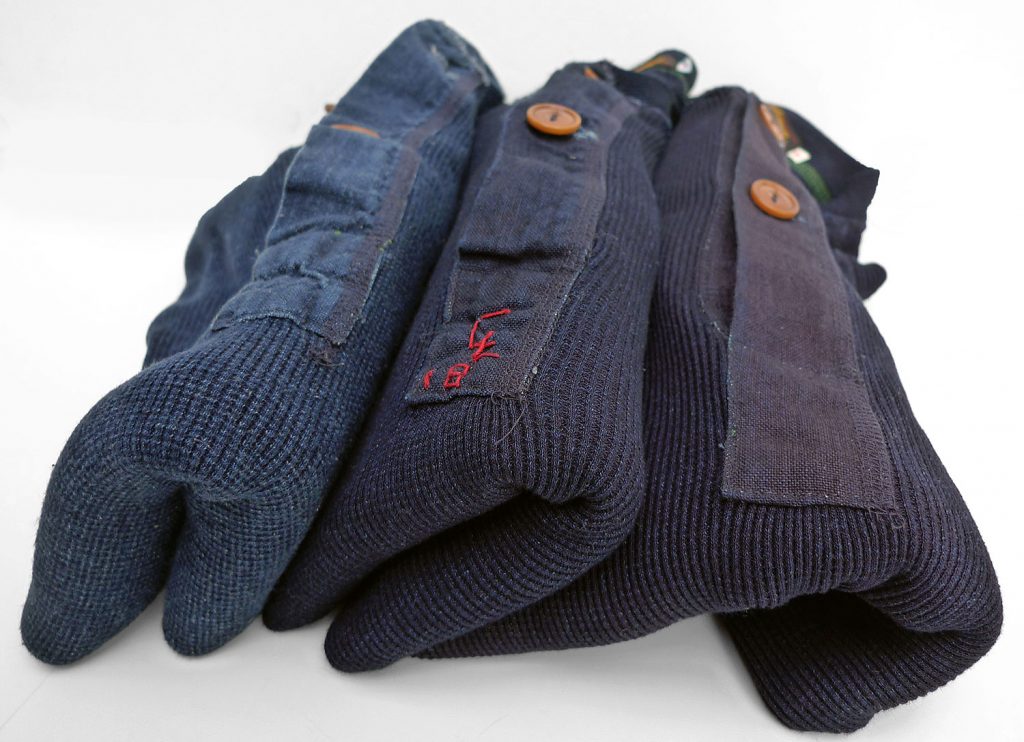
Mister Freedom® “G.I.” Two-Button Shirt, NOS indigo cotton Fisherman’s rib stitch jersey knit.
“The Sportsman” catalog, Fall 2018.
Made in USA.
In true Mister Freedom® fashion, we will “render unto Caesar the things that are Caesar’s” and duly credit Uncle Sam for the pattern of this garment, as we shamelessly lifted this “henley” shirt design from a US Government-issued cold weather classic from the 1950’s. Initially released under the “Undershirt, Winter, M1950” moniker, it is sometimes referred to as the “Wallace Beery” shirt.
The M-50 (model 1950) was adopted by the U.S. Army QMC in 1948, and, starting in 1950, a set of three shirts was issued to American soldiers heading out to Korean battlefields.
We are all familiar with the original military version, the unbleached wool merino-cotton blend knit shirt with the two large white buttons, and its superseding brown 436 issue, both quite a staple of old-school Army/Navy surplus stores.
-
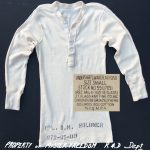
-
Original vintage US Army M-50 undershirt.
-
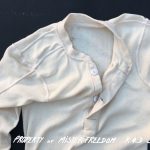
Following our typical modus operandi, we decided to “civilianize” this classic US Army undershirt. For a fashionable make-over, we tapped into the final precious yardages of New Old Stock indigo cotton jersey, the handsome deep dark indigo blue yarn-dyed 100% cotton “Fisherman’s rib stitch” jersey knit, milled in USA, previously featured on the MF® Chandail Saint-Malo. The technical knitting term “Fisherman’s rib stitch” refers to the fabric’s specific weave, displaying a vertical pattern of fine ribs, with somewhat of a ‘waffle’ aspect reminiscent of vintage thermal shirts.
For the button placket, departing from the original M-50 military design with its simple matching knit placket, we decided to spice things up with extra indigo goodness. Although not quite visually noticeable at first glance, the placket is cut from a contrasting NOS plain-weave fabric, of an almost matching dark indigo color. This not only makes the button front closure sturdier than the loose-weave jersey, but also creates an attractive subtle contrast in both texture and color, promising of an interesting patina down the line.
Like the military original, our “GI” indigo shirt features the characteristic utilitarian flatlock stitch overall construction, the stretch-resistant reverse weave top shoulder gusset, the unusual inverted top seam arm stitching, the wide self-fabric cuffs, and the two ‘oversized’ cat-eyes buttons. We opted for fancy corozo wood for our version, in a complimenting rich amber brown color.
Just like with the production of the Saint-Malo, the specific horizontal mechanical stretch combined with fabric shrinkage made manufacturing the GI shirt a tour de force for our local factory. It took nearly one year of challenging sample-making and pattern-adjusting to get the fit, stitching and proportions right. After all that R&D challenge, we are quite ecstatic to finally add this little guy to the ever-growing MF® Sportsman catalog.
Style-wise, our “G.I.” Two-Button Shirt is quite versatile and can be worn as a thermal-type undershirt, as a single-layer shirt, as a light sweater over a summer-weight button shirt, like a Nixon chambray for instance. Tucked-in old-man style to compliment the classic wedgie look dear to our model, or untucked, for the younger crowd.
As always, our shirt is not available factory distressed. The subtle and attractive heather quality of the deep dark indigo will intensify as the garment fades with normal wear/wash cycles. See photos featuring a well-worn and frequently-washed early prototype, next to the freshly-issued version, for the rewarding results of naturally faded habiliment.
It is the nature of deep tone indigo-dyed garments to transfer some of the indigo blue color to other surfaces, from abrasion. The MF® GI Two-Button shirt is a real bleeder, both from the knit and woven fabric parts. On a side note, this is probably the reason why this fabric was never cut into garments, and ended-up as New Old Stock, to our delight. To avoid the soup sandwich of complains and merchandise returns, a (mystery) brand responsible for having milled this amazing indigo knit jersey likely cancelled whatever project they had with it, after realizing everyone’s hands were turning blue…
Well, we picked up where they left off, and happily played with their unwanted toy! One of the perks of being part of a small independent label, is the reassurance of a bright, responsible, adult audience, such as the one we have been cultivating for the past 12 or so years. We are so indebted to our customers for the opportunity and privilege to design all sorts of challenging, eclectic, offbeat wearables, seasons after seasons, sustainably and regardless of trends. Thank you all, Mister Freedom® ❤️ you!
CAVEAT EMPTOR: Although the indigo connoisseur will relish in the deep dark tone, the MF® “G.I.” shirt might not be an ideal garment for the faint-hearted or laundry-challenged. Indigo crocking will perdure even after several wear/wash cycles. I’ve had a blue torso from wearing mine without an undershirt! The shirt’s indigo blue will definitely rub-off on light-color garments, sofas, car seats, walls, skin, etc… Color transfer should easily wash-off with regular laundry methods, but we definitely recommend not wearing white undershirts, white shirts or white jackets with this garment for a while.
Indigo color transfer will eventually subside after about 10 wear/wash cycles, and the knit fabric settle to a beautiful typical indigo hue.
The MF® G.I. Two-Button Shirt is designed in California by Mister Freedom®, and manufactured in USA, from American NOS fabric.
FABRIC:
New Old Stock 100% cotton “Fisherman’s rib stitch” jersey knit, deep dark indigo blue yarn-dyed, milled in USA.
Note: Although not overly light-sensitive, expect substantial color crocking with this specific indigo knit fabric. It is the nature of indigo-dyed garments to transfer some of the indigo color to other surfaces, from abrasion.
SPECS:
* An original MF® pattern inspired by vintage 1950’s Government-issued US Army M1950 two-button front cold weather undershirts.
* Utilitarian flatlock stitch overall construction.
* Corozo wood buttons.
* Contrasting indigo-dyed plain-weave fabric button placket.
* Stretch-resistant reverse weave top shoulder gusset.
* Wide self-fabric cuffs.
* Inverted top seam arm stitching.
* MF® Sportsman trademark contrasting green inside stitching.
* MF® Sportsman woven label.
* Made in USA.
SIZING/FIT:
After an initial cold rinse and heat dry cycle, the MF® G.I. Two-Button Shirt will fit pretty much like our popular Stanley T-Shirt, but with much more ‘elasticity’ (mechanical stretch). If you are familiar with our Skivvy and Stanley T-Shirts, our Tricot Marin fits like a Skivvy, while our GI shirt feels more like the Stanley, due to similar fabric stretch properties.
I wear a Small in Stanley and Skivvy, and usually Medium in mfsc button shirts. I opted for a size Small in the GI shirt, with a snug initial fit that loosened-up gradually while wearing the shirt. After a day of normal wear, the shirt’s body expands a few inches in width, minimally in length. If the pattern has been specifically adjusted to avoid an unattractive “boxy” silhouette, a Small in the AM feels somewhat like a Medium in the PM.
Basically, the GI shirt will shrink to a tighter fit after laundering/heat dry, but easily expand again with wear as the knit fabric loosens up.
If you are in-between sizes, or worried about an overly-relaxed fit, we recommend sizing down on the GI shirt. As always, which size will work for you depends on your own aesthetics, body type, preference for ‘vintage’ silhouette or contemporary fit.
Refer to sizing chart for measurements, taken with the item laying flat and NOT stretched. Do keep in mind the mechanical stretch aforementioned, and expect the shirt to gain an inch or two in width as it is worn and naturally stretched over the torso.
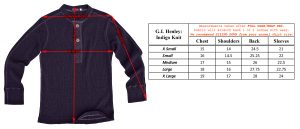
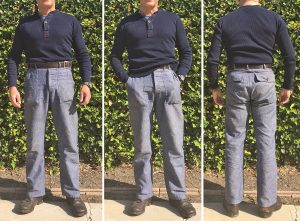 Mister Freedom® GI Two-Button Shirt, size SMALL (washed/dry). CARE:
We recommend cold wash with eco-friendly detergent, heat dryer. Wash and dry separately to avoid color transfer to light color garments.
DISCLAIMER: Beware that this indigo garment will ‘bleed’ through several wash/wear cycles, and color transfer will occur on other garments, furniture, car seats, skin, washing machine and heat-dryer drums. It is the nature of indigo-dyed garments to transfer some of the indigo color to other surfaces, from abrasion.
This indigo color transfer will eventually subside after about 10-15 wear/wash cycles.
Available raw (un-washed)
Sizes
X-Small
Small
Medium
Large
X-Large
Available from www.misterfreedom.com, our Los Angeles brick & mortar store, and fine retailers around the World.
Email sales@misterfreedom.com or call 323-653-2014 with any questions unanswered above.
Thank you for your support.
Christophe Loiron
Mister Freedom®
©2018
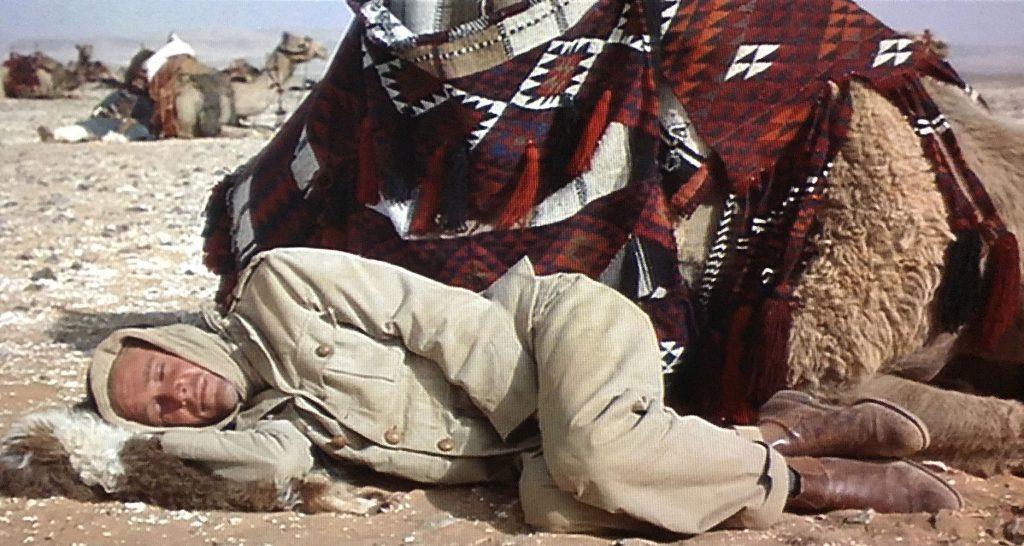   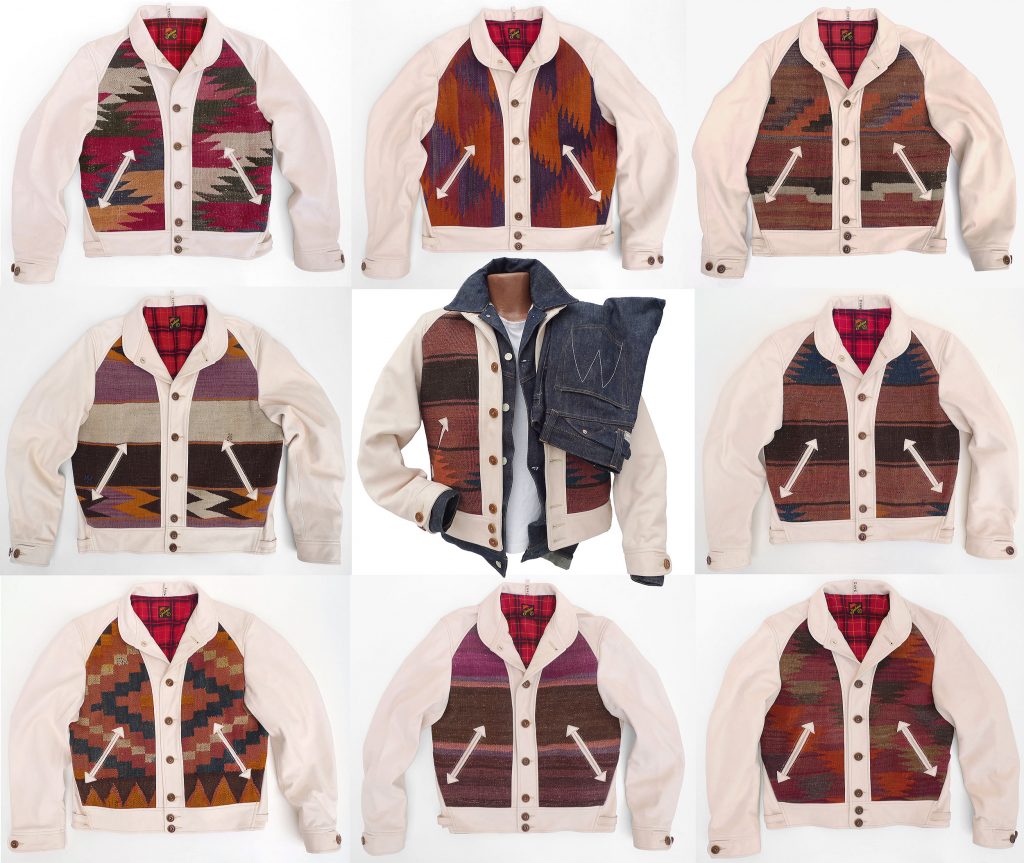

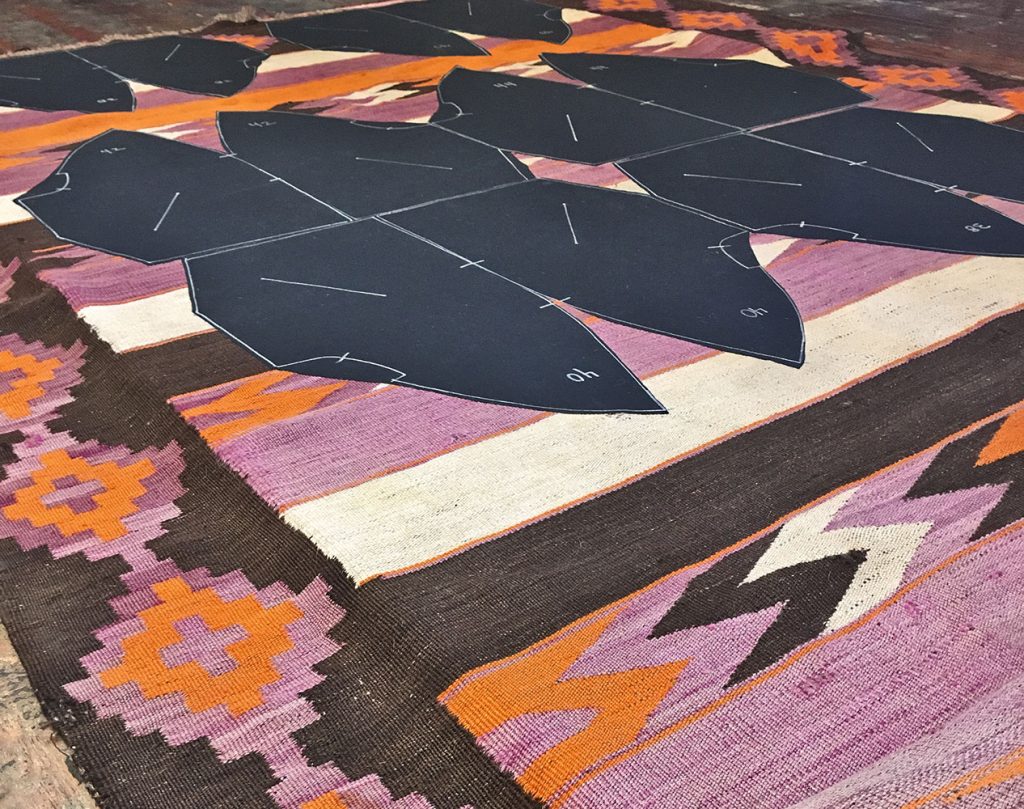
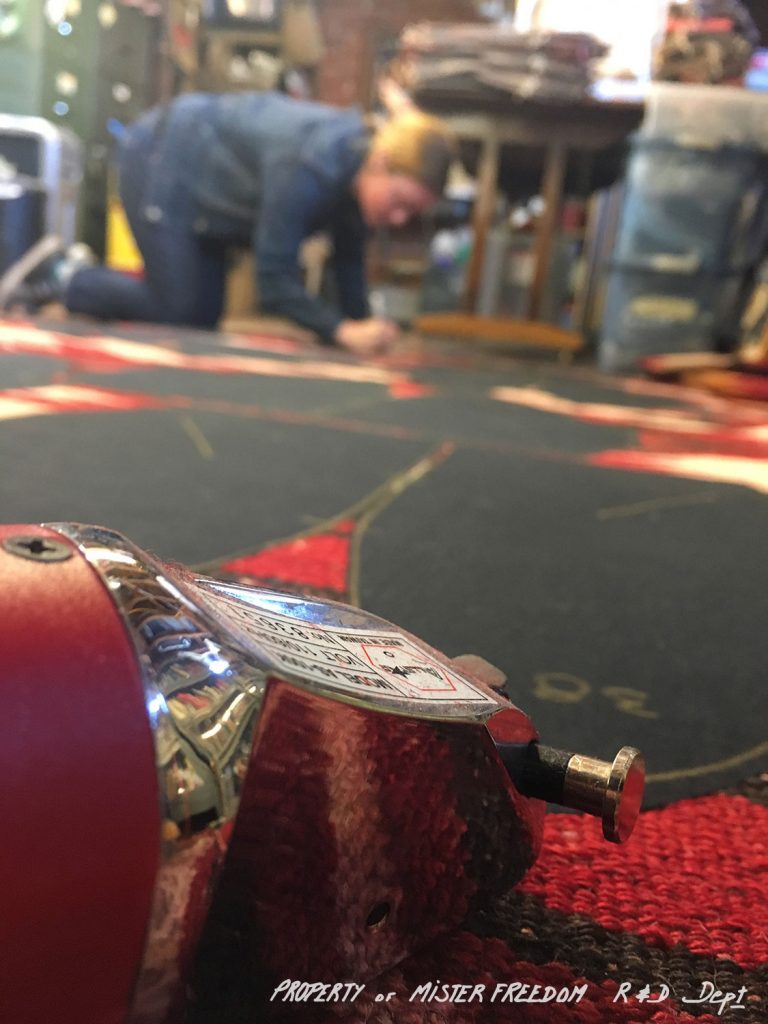
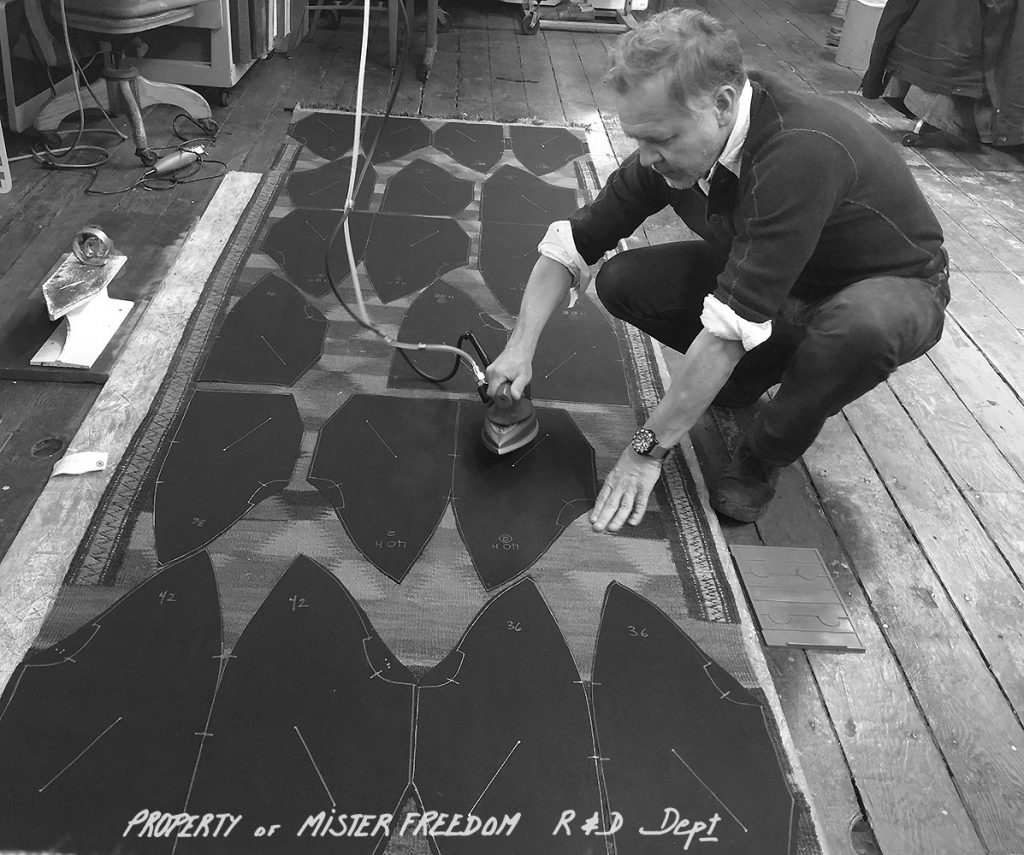
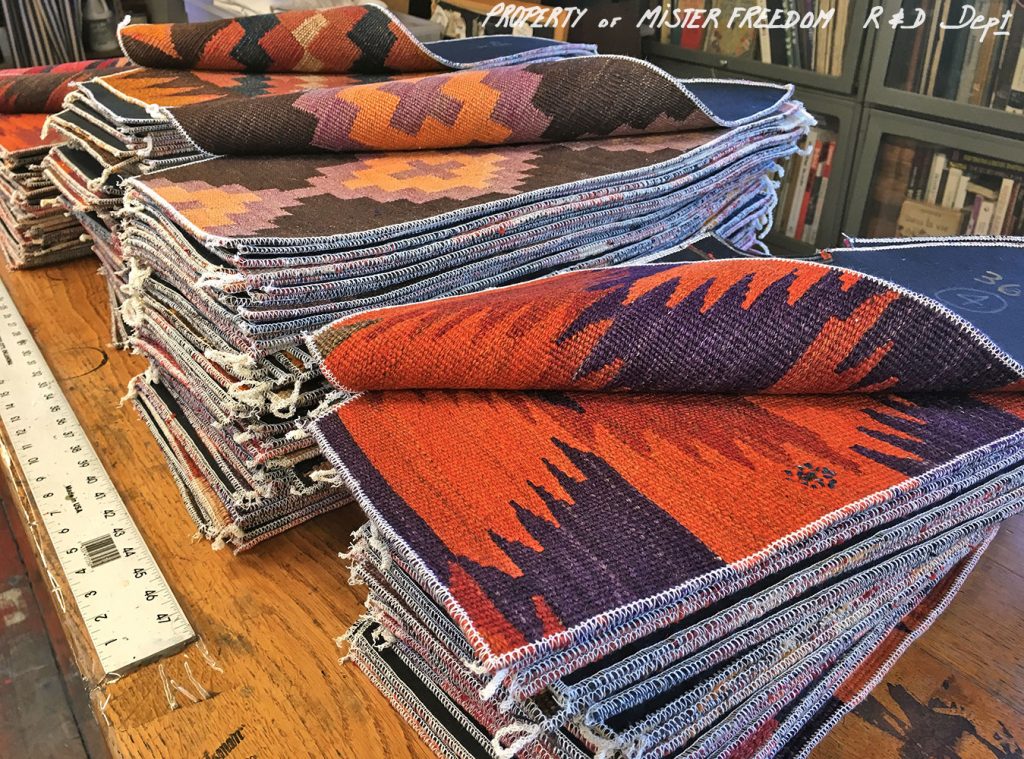 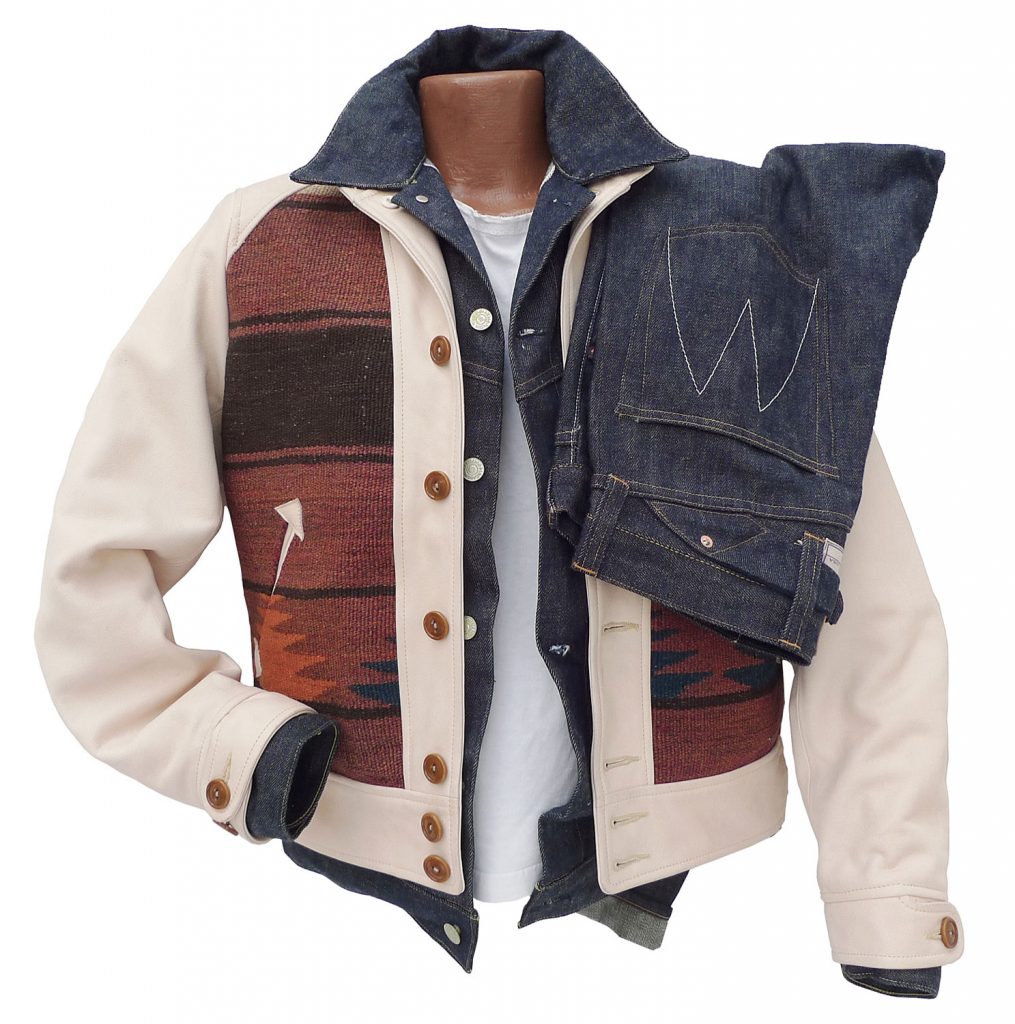
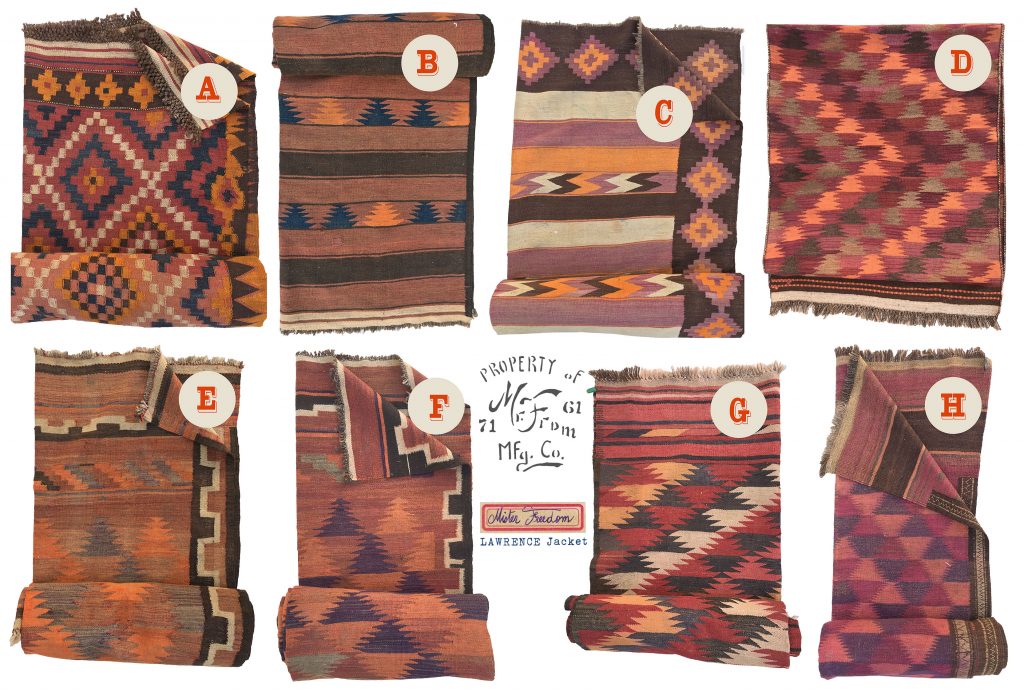
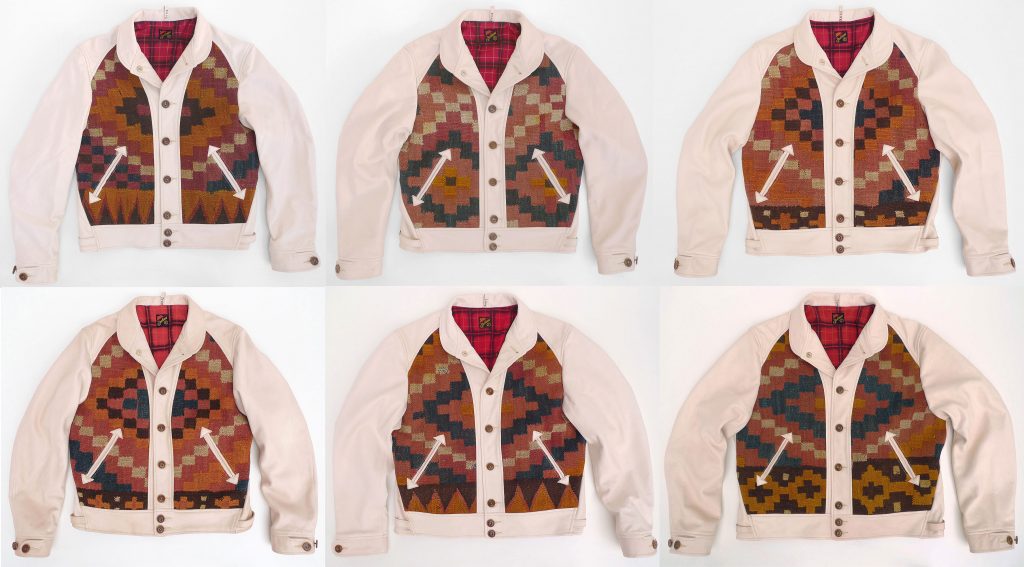 Mister Freedom® “Lawrence” Jacket, Caravan A. 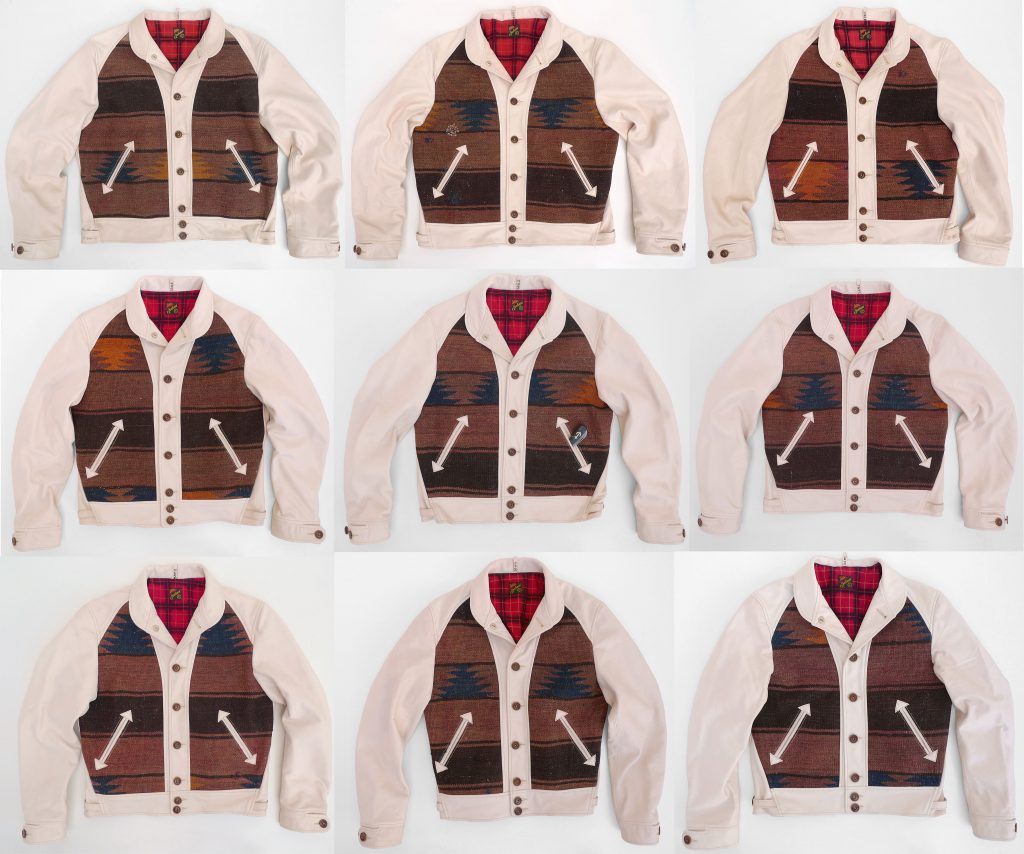 Mister Freedom® “Lawrence” Jacket, Caravan B. 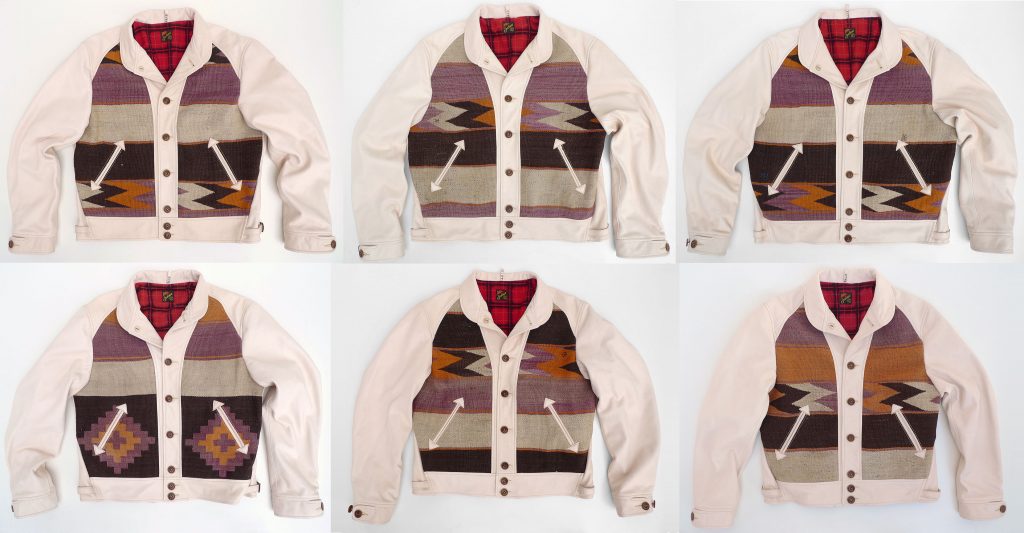 Mister Freedom® “Lawrence” Jacket, Caravan C. 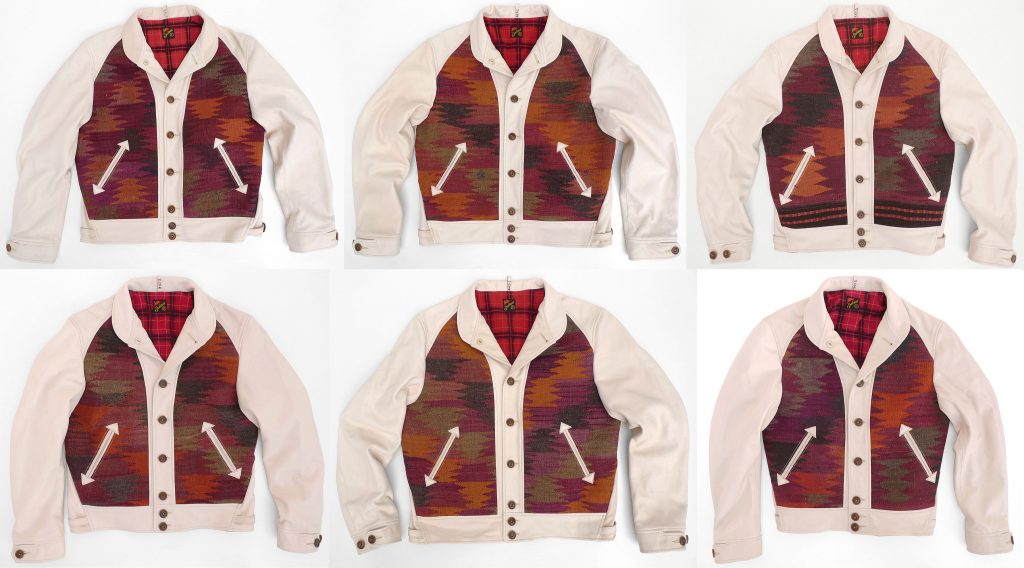 Mister Freedom® “Lawrence” Jacket, Caravan D. 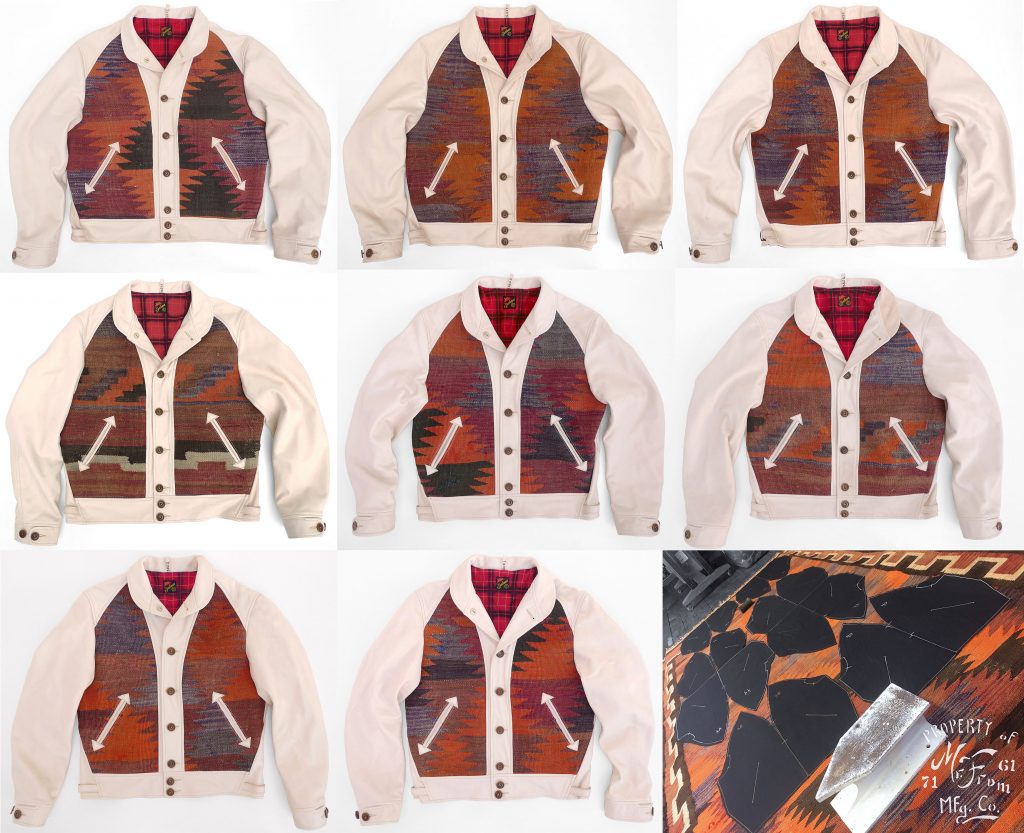 Mister Freedom® “Lawrence” Jacket, Caravan E. 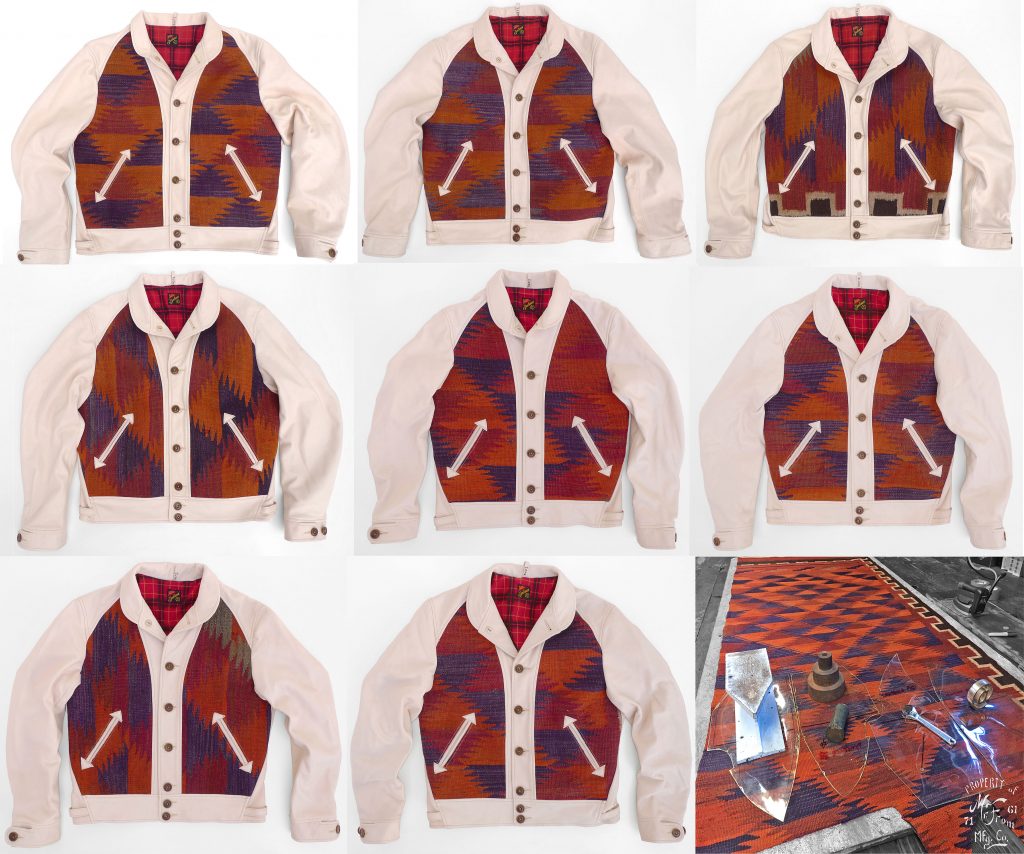 Mister Freedom® “Lawrence” Jacket, Caravan F. 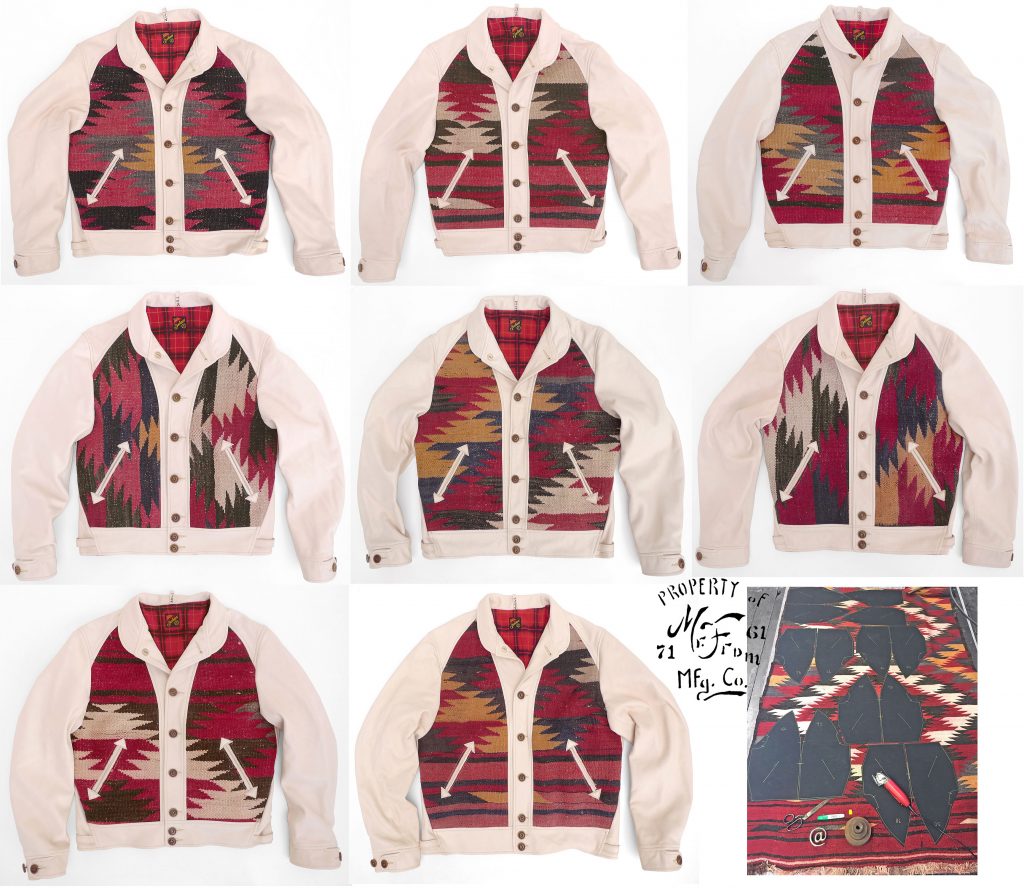 Mister Freedom® “Lawrence” Jacket, Caravan G. 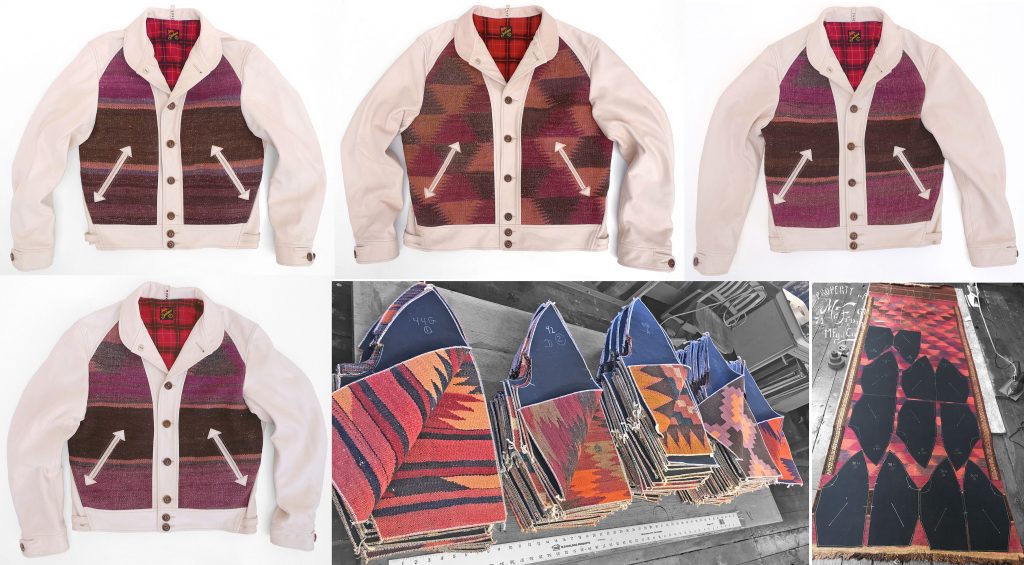 Mister Freedom® “Lawrence” Jacket, Caravan H.
Mister Freedom® “LAWRENCE” Jacket, up-cycled antique Kilim rugs/blankets.
FW2018 Limited Edition.
Made in USA.
For this glorious season, we concocted a special one-of-a-kind rendition of the Mister Freedom® Baloo jacket, the furry little number we had introduced last Fall. The Baloo, our interpretation of the popular 1930’s “grizzly” type leather coats, and a bear necessity for the classic leather jacket connoisseur today, got back to the drafting table for a new wacky spin à la MF®.
We are calling this Fall 2018 garment the “LAWRENCE”, a reference to the wild Arabian adventures of famed British archeologist, camel-riding diplomat, khanjar-toting gentleman, gone-native Army Captain, Thomas Edward Lawrence.
Having watched Lawrence of Arabia‘s exciting silver screen saga one-time-too-many (cue-in Maurice Jarre’s haunting score), someone at the office had the balmy idea of spicing-up the ol’ MF® Baloo pattern with a dash of exotic oriental flavors!
Taking the usual MF® liberties with geography, cultural authenticity, historical accuracy and common sense, it was decided to blend antique oriental textiles with our classic leather jacket. By incorporating into our USA-made Baloo pattern a mixed bag of vintage rugs or blankets out of the “Rug Belt” (think bygone Persian and Ottoman Empires, the Middle East and South Asia), our plan was to deliver a somewhat plausible local souvenir that ‘Aurens could have brought home from his tumultuous epic travels, a custom-made jacket to go ride his Brough Superior around, Bedouin-style, back in the peaceful English countryside.
Now, this one is for the social media… The following exchange allegedly took place on a distant shore of the Red Sea, sometime in 1917, as reported by a reliable source claiming to be present at the time. This bizarre bazaar encounter is not a well-documented episode, and although its accuracy will fiercely be debated on 4chan in the coming years, historians we consulted have all confirmed it with an eye roll. So, do quote us on it, and remember where you heard it here first. This is how it was relayed to the MF® Editorial Dept., verbatim:
Souk merchant: “Yalla, English! I have nice jacket for you, souvenir from Aqaba! Has your name written on it, wallah!”
T.E. Lawrence: “Nothing is written, my good lad. Oh… wait… dude! That’s one funky fresh jacket!!”
Souk merchant: “Shukran ‘Aurens, I knew you’d dig it, habib! Toldja, mektoub! Now, paper or plastic?”
(?)
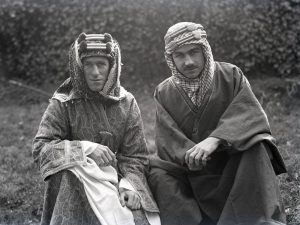 “Yep, that’s pretty much how it happened.” Words unpronounced by T.E. Lawrence & Lowell Thomas, London, 1918 (Image ©Marist College) Above photo of “T.E. Lawrence & Lowell Thomas sit in London session portraits” 1918 courtesy of ©Marist Archives, in accurate historical context here.
In regards to style, the following statement might make anthropology textile experts cringe (they probably already left this page realizing we’re about to chop-off collectibles to turn them into “fashion” items anyways), but an amateur might point out visual similarity between certain Kilim traditional patterns and some of their hand-woven Native American counterparts. For the profane (that’s us), geometric symbolism such as tribal stripes, the famous Eye-Dazzler pattern, diamonds, stars, running water, or multicolor Anatolian Manastir motifs, do bring to mind works of early and contemporary Navajo or Pueblo weavers, and other skilled loom artists who contributed to the production of rugs and blankets of the American Southwest. The commun thread, we believe, is that commercially-produced traditional crafts of a specific ethnic group will inevitably evolve with outside demand, bartering, raw material and dye imports, foreign tastes and eventual cultural assimilation. Similar designs and symbols appear along trade routes, distant styles end-up overlapping, making cultural authenticity somewhat of a subjective concept with artisanal handicraft. So, expect an occasional “awesome Indian blanket jacket, dude!” comment, while sporting your MF® Lawrence.
After this colorful ouverture, and rather than sharing an uneducated opinion on current Arab affairs and oil barrel prices, here are a few highlights of our own saga with the MF® “Lawrence” production, for the insomniac few.
As often with USA-made projects we embark on, comes the moment we all look at each others at the HQ, with the same puzzling question: “Who the *%$#&* thought that was a good idea?” Even our intrepid MF® R&D Department expressed doubts during manufacturing…
First, we had to source the full grain veg-tan leather hides, all inspected one by one for grain, overall quality and feel. This is the same grade of leather we have been using since 2013 for the MF® Campus, and its Baloo successor. The hides are very light sensitive and initially almost ivory white, until exposed to natural daylight. The leather gradually sun-tans to a pinkish hue, eventually developing attractive golden tones.
Then, Hut, Hut, Hut, off we went on a hunting safari for vintage rugs!
We found a local Ali baba’s cave, the vault of a Pakistan-born textile expert, a gentleman specialized in legally-imported, well-documented antique oriental rugs. Going through dozens and dozens of stacked-up specimen, we focused on flat-woven Kilim rugs of the non-pile (flat weave) and non-slit family (no “openings” in the weave.) We carefully selected candidates from the first half of the 20th Century that aesthetically and technically qualified for the project. Each rug was hand-picked for its attractive geometric motifs, vintage appeal, fine color combination, unique hand-woven imperfections, occasional period hand-repairs and overall natural patina. These are woven from wool and cotton yarns, dyed in unstable, non-colorfast natural dyes, often leading to subtle color runs. This is part of their wabi-sabi charm, and the uniqueness separates them from Ikea’s versions. The kilim expert mentioned that, back home, these rugs served as wall-hanging decoration, blankets, home carpets, camel saddle covers…
Considering the latter, we took our loot to a professional cleaning facility specialized in antique rugs, an impressive old-school operation established in Los Angeles in 1926, a recommendation from our friend Channon at In The Field. We had each rug thoroughly hand-brushed, hand-washed and sun-dried, without the use of machines, quite a costly procedure, almost doubling the cost of each vintage piece!
Came the time to unroll the freshly-clean rugs back in our atelier, and figure-out how to turn them into front panels of jackets… To strategically cut according to each rug design, while trying to envision each finished jacket with well-balanced panels, we thought of making our pattern paper out of clear PVC.
It soon hit us that there is nothing remotely symmetrical in a nomadic tribal rug, hand-woven on an horizontal floor loom, somewhere in a remote mountainous region of Pakistan, some 80 years ago. Eye-balling seems to be the golden rule in metrology for the Rug Belt artisans.
After a few hours of deliberation, positioning and repositioning the pattern markers, we traced panels on each rug, combining sizes and grain direction. We then painstakingly fused the panels with high-quality woven cotton fusing, using an industrial steam iron. We, of course, chose to do this during the hottest months of summer, to fully embrace the benefits of facial steaming.
Each panel was then cut using electric shears, somewhat of a liberating experience, and carefully overlocked to avoid later fraying of the edges.
After completing this portion of the hands-on production, we resumed our water-skiing activities and badminton tournaments. The MF® atelier’s contribution was temporarily over! The jackets themselves, however, still had to get made…
We happily passed the hot potato to a local facility, who, in-turn, couldn’t wait to throw it back at us. The factory’s expert craftsmen had never worked on such a “fun” project, involving new leather and eclectic vintage textiles. Most places would have turned us down, so we are indebted to our small manufacturing source for accepting the challenge. After a few months of intricate and complicated assembly work, production management headaches and anxious back-and-forth, our Lawrence Jackets were ready! Ready, that is, for the final touch back at the MF® HQ: hand-sewing hundreds of corozo double buttons, which gets old after about five.
We are, many months later, proud to announce our one-of-a-kind and once-in-a-lifetime MF® “LAWRENCE” jackets! We hope you enjoy the finished product as much as we got our kicks during the manufacturing fantasia!
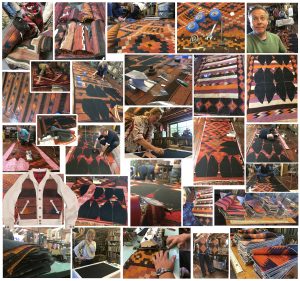 The Mister Freedom® “Lawrence” Jacket saga ©2018 As one will guess from the making-of collage, the yield (number of panels per rug), selection of sizes cut per rug, and geometric design variations per panel within each rug, all got out of control pretty quick. We had realized early-on that no-two jackets were going to be the same, making the MF® Product Photography Department quiver in anticipation of this post.
For inventory purposes, we have regrouped the MF® Lawrence jackets in eight families (called them caravans), according to the specific vintage Kilim rug they were cut from (Caravan A, B, C, D, E, F, G, or H). Not every rug yielded a full size scale, and availability of the MF® Lawrence jacket will be limited to this FW2018 batch.
DISCLAIMER:
* VEG-TAN LEATHER: The Mister Freedom® Lawrence Jacket is cut from genuine leather. We use full-grain, and not “top-grain” leather (aka corrected or buffed leather, sanded to level surface inconsistencies). No two hides are alike and each panel may feature variations in texture along with natural imperfections.
* The occasional nicks and marks on the hides we select are characteristic of pasture-raised cattle, with the implication of natural scarring from roaming and being in contact with other animals. Considering the obvious perks of outside grazing for the cattle, vs. confined indoors or in pens as required for the production of some luxury leather goods, we find these natural imperfections to be perfectly acceptable, if not a desirable trait of a Mister Freedom® leather garment. These “life” marks are inherent to full grain leather, and will blend into a natural patina when our jacket is worn, conditioned and lived-in.
* Early signs of tanning of panels may, at times, be visible on a finished garment, as we pay premium to have our leather goods produced in a pleasant, well-lit, clean and ethically-run California facility. We’ll leave the dark, un-safe, regulation-evading basements where less-fortunate workers toil, to less-regarding fast-fashion labels catering to the modern consumer’s insatiable appetite for “affordable” disposable goods. In other words, we do not consider a new jacket with partially-suntanned panels a defective garment.
* RECYCLED KILIM RUGS: The front panels feature genuine vintage kilim rugs/blankets that are about 70 to 90 years old. These can show signs of wear and natural patina, color fading and crocking, woven imperfections and unevenness, design pattern asymmetry and occasional rugged hand repairs. Due to Mister Freedom®’s background in vintage clothing, we consider these imperfections desirable. These natural flaws are inherent to up-cycling projects, such as turning antique textiles into new unique garments, still fit as wearables for next generations.
Thank you for your understanding.
The MF® LAWRENCE Jacket is designed by Mister Freedom® and manufactured in USA, from USA-sourced hides and up-cycled genuine vintage Oriental rugs of the Kilim family.
SPECS:
PATTERN:
Inspired by 1930’s “Grizzly” type leather jackets, and other vintage American sportswear and outdoor garments, and somewhat by the 1962 film “Lawrence of Arabia”.
The original MF® Lawrence jacket pattern is adapted from our MF® Baloo jacket pattern, in turn adapted from the MF® Campus jacket.
MATERIALS:
* Shell: Vegetable tanned leather, full grain cowhide, milled and supple, natural finish and color, about 2-3 Oz weight, sourced in USA.
* Front panels: Up-cycled vintage Oriental rugs of the Kilim family, with a probable provenance in Pakistan and surrounding regions.
* Lining: 100% cotton brushed flannel with a 1940’s-50’s-inspired vibrant plaid pattern, discharge-printed. Fabric milled in Japan.
DETAILS:
* Vintage 1930’s style, inspired by cossack-type and Grizzly-type panel leather jackets.
* Fully lined with a soft cotton brushed flannel featuring a vintage style discharge-printed plaid pattern.
* Front panels cut from a vintage genuine Oriental Kilim rug.
* Full single panel veg-tan leather back.
* Slash pockets with arrow-head pocket stops.
* Side gussets with adjustable side straps (NOS metal slide buckles)
* Keyhole button holes.
* Corozo ‘Cat Eyes’ wood buttons, backed by vintage-style corozo wood “cat-eyes” buttons.
* Mister Freedom® woven “Sportsman” label.
* American-sourced hides.
* Limited Edition. Each jacket is a one-of-a-kind collectible.
* Made in USA.
SIZING:
The MF® LAWRENCE Jacket is true to size. I am usually a 38 in mfsc jackets and opted for a 38 in the MF® LAWRENCE, with enough room for a lightweight layer underneath.
The fit is relatively snug, so we do not advise sizing-down on this garment if you are in-between sizes. If planning on layering with heavy cable knit wool sweaters, consider sizing up in order to be able to comfortably button-up the jacket.
Refer to sizing chart below for approximate measurements. Please consider the thickness of the leather/Kilim/lining when trying to match your chest measurements and the jacket’s measurements. If still in doubt, please contact sales@misterfreedom.com with your specifics for recommendations.
CHART
CARE:
We recommend wearing the jacket as-is. No specific initial conditioning or pre-treatment is required. Just wear and enjoy witnessing the natural ageing and patina evolution.
According to frequency of wear and exposure to the elements, some light conditioning might be applied to the sleeves after months of continuous wear, using products similar to Pecard Antique Leather Care. Be aware that conditioning will darken the leather, and should only be applied with care and expertise.
* Do not dry clean. Even professional leather cleaning facilities might not be competent on how to treat the specific LAWRENCE jacket veg-tan leather/woolen woven rug/cotton lining combo.
* Do not use heavily-oily products designed for footwear, such as neatsfoot oil.
* Do not attempt to “wash” the Kilim woven panels. Use a dry, plastic bristle brush for cleaning if needed.
* Should leather parts of your jacket get accidentally stained from normal wear, consider this a normal stage of the evolution of an outdoor garment. As often witnessed on well-worn vintage leather jackets, wear, stains and scratches will eventually blend-in into the most attractive and unique patinas.
Available NATURAL.
Sizes
36 (Small)
38 (Medium)
40 (Large)
42 (XLarge)
44 (XXLarge)
Front panel styles/patterns: regrouped in eight kilim families/caravans: A, B, C, D, E, F, G, or H.
Not every rug yielded a full size scale, and size/style/pattern availability is limited to this FW2018 batch.
Not all jackets were photographed, but each caravan grouping is representative of the available selection.
Note on inventory: Each jacket is numbered on the collar loop (example 38G1). The letter in the code does indicate the specific rug, but, due to the similarity in some of the woven designs, some jackets have been attributed to the wrong kilim rug during the numbering. For instance, the Lawrence jacket 40F3 is actually cut from Kilim D and should have been marked 40D3. Its photo file was renamed 40F3d, but the jacket itself was not re-branded on the collar loop.
Available from www.misterfreedom.com, our Los Angeles brick & mortar store, and fine retailers around the World.
Email sales@misterfreedom.com or call 323-653-2014 with any questions unanswered above.
Thank you for your support.
Christophe Loiron
Mister Freedom®
©2018
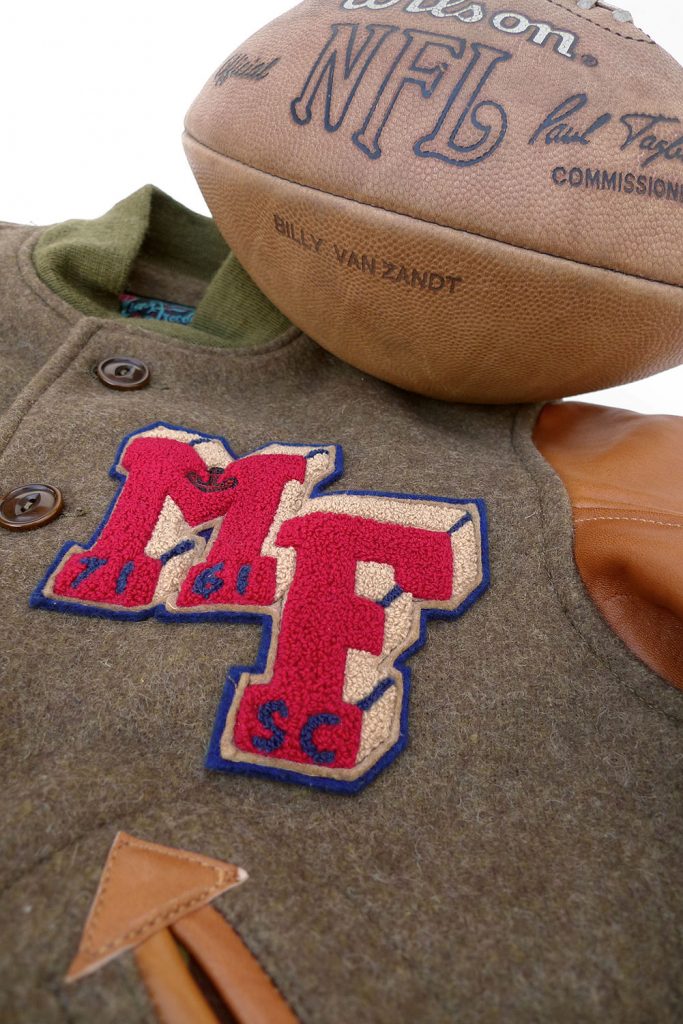 Wait, who? 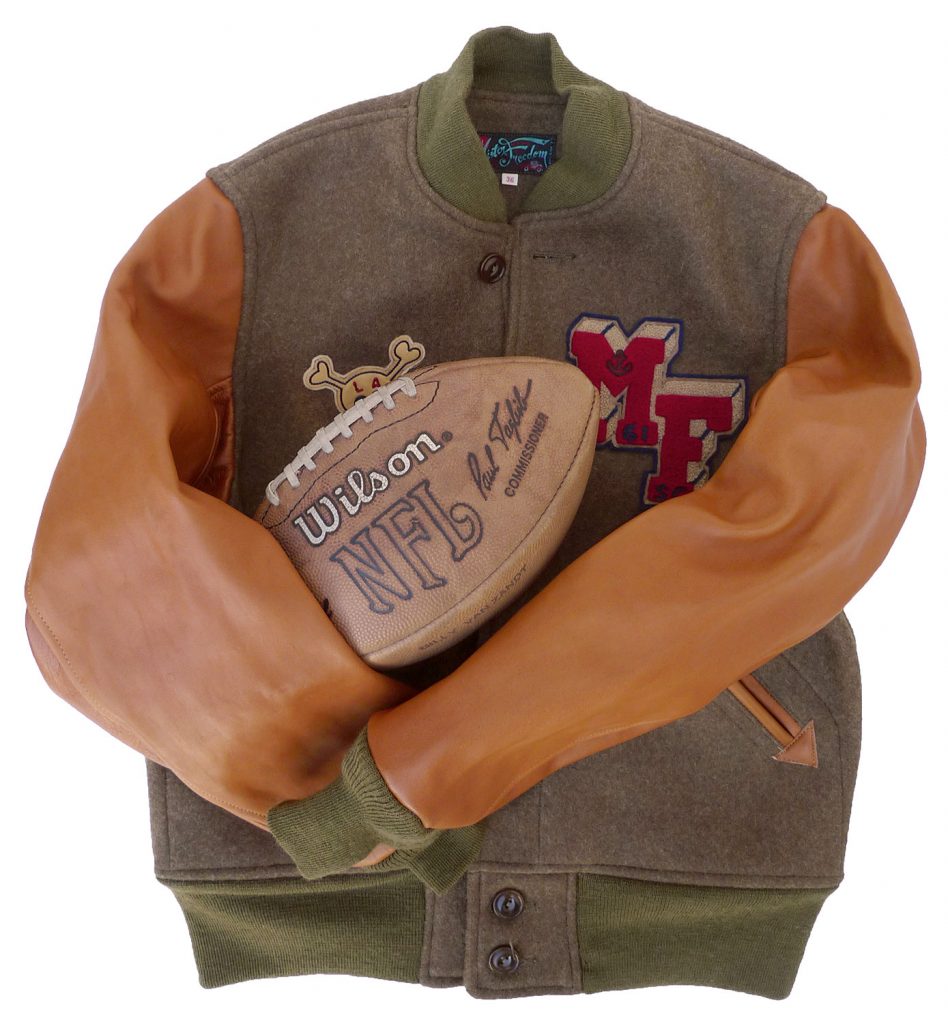


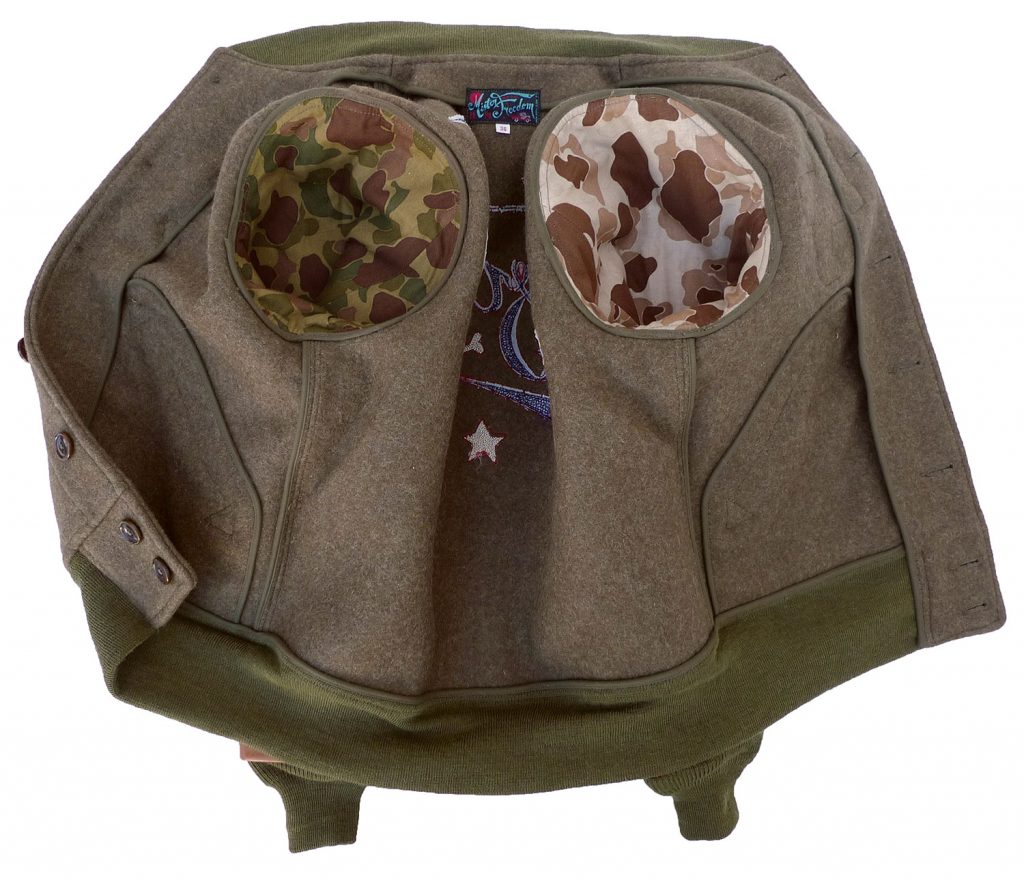
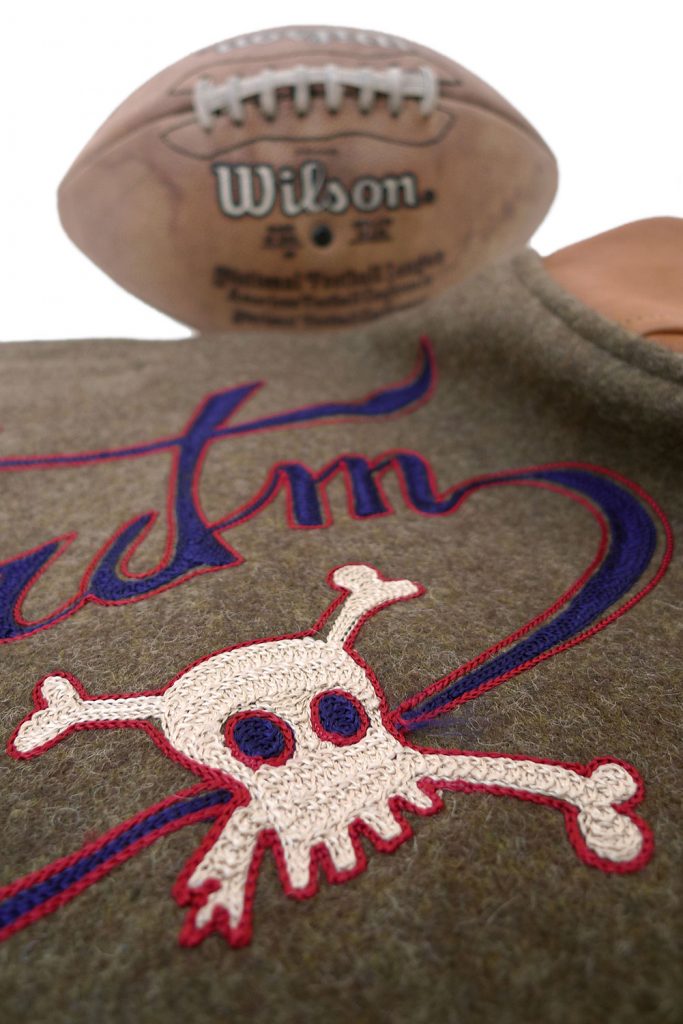
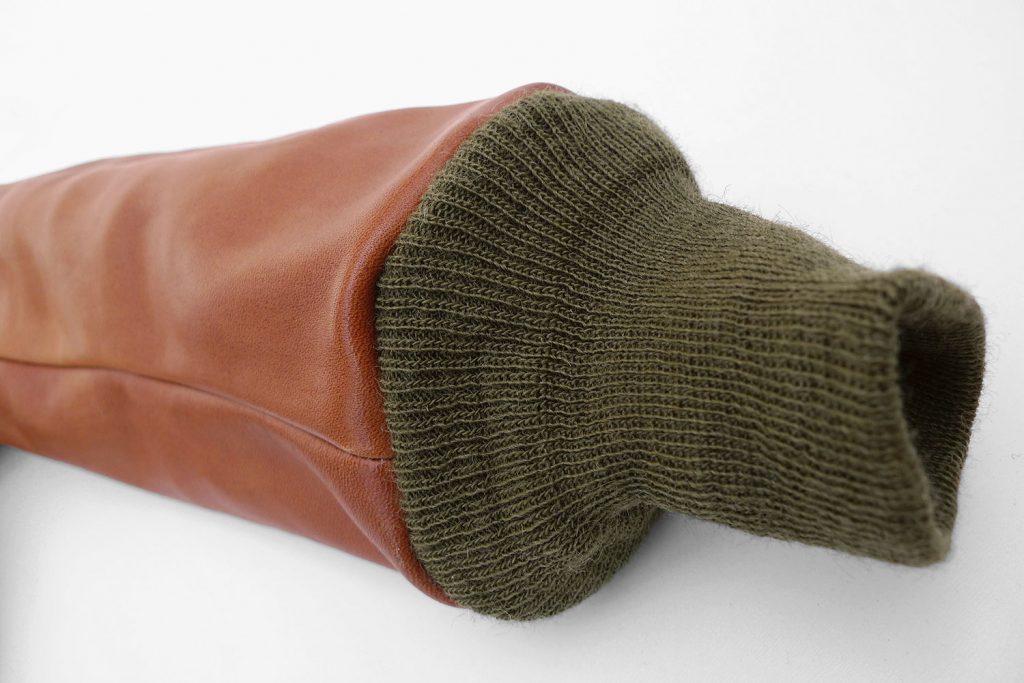
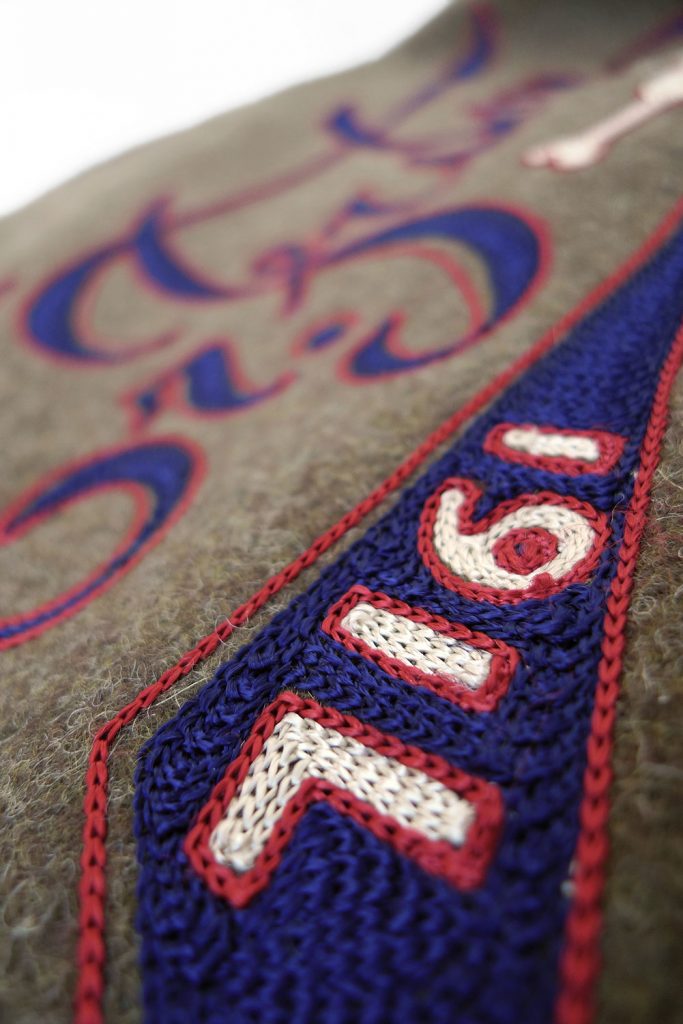 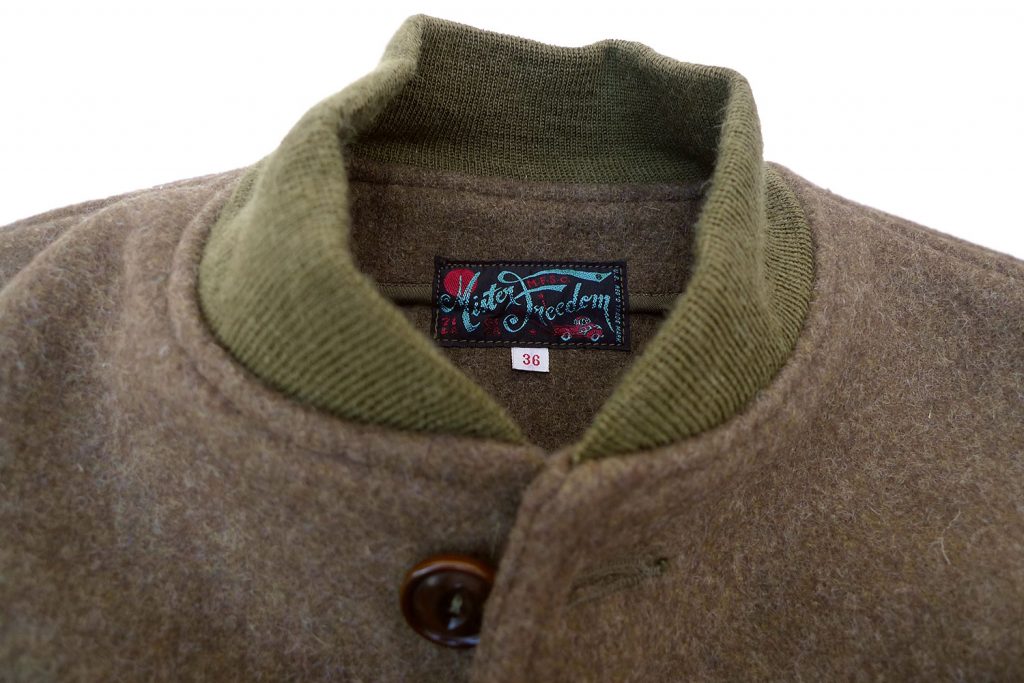
Mister Freedom® HEADQUARTERS Jacket, Yarn-dyed wool & Horsehide leather.
FW2018 mfsc Surplus collection.
Made in Japan.
Call them varsity jackets, letterman jackets, award jackets, baseball jackets… or “teddy” as they are referred to in France, here is the Mister Freedom® twist on this all-American classic. The tradition of outfitting meriting high school and college students with a lettered garment appears to be historically anchored in Harvard’s original baseball team of 1865… Apparently, the ritual of customizing one’s sport sweater with the varsity’s emblem and school colors extended to wool or leather-sleeved jackets sometime in the 1930’s.
American letterman jackets have gone through a few style variations though the years, raglan sleeves, all-wool bodies, hoods for the ladies, …, but the characteristic chenille and felt letter patches have always remained, and are today a staple of vintage Americana. The trademark contrasting leather sleeves of the classic models have gone through a questionable vinyl period in the 1980’s, as the rack of used letterman jackets of your local vintage store will attest to.
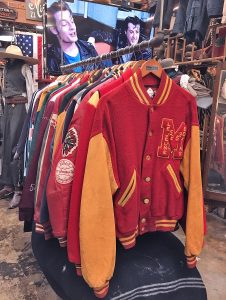 Your favorite local vintage pile o’ rags, if you lived around 7161 Beverly Blvd., LA, CA 90036, USA.(Check out Sly in 1974 in “The Lords of Flatbush”!) We, as often, took liberties with authenticity when designing our own letterman-style jacket, twisting the concept into more of a cool “club jacket” than a sport jock uniform per-se. More Fonzy than Ritchie. Like The Lords of Flatbush meet The Wanderers, with a Camp Pendleton twist…
There is indeed a military vibe to our “Club House” jacket, aka MF® HEADQUARTERS jacket. Probably due to the choice of the olive green yarn-dyed body, a hefty wool fabric found on vintage US Army coats, matched by 1940’s tanker jacket olive green knit cuffs and collar, all borrowed from Buzz Rickson’s outstanding mil-specs trim ressources. Buzz also supplied the HBT cotton “Duck Hunter” M1942 reversible camo (aka “Frogskin”) we lined the horsehide leather sleeves with. The slash pockets are also intricately lined with frogskin, subtly displaying both jungle/beach contrasting camo sides, a pattern-making and tailoring prowess if you look at how it’s constructed. The pocket openings are trimmed with the same cognac brown-colored horsehide leather that pairs so-well with the olive green wool, a color combination we’ve always found attractive.
We opted for an early baseball jacket pattern, featuring 1930’s-40’s style button-front closure, as opposed to the later, more typical, snap button versions of the 1960’s and 70’s. The choice of unlined construction with impeccably-taped seams is also a reference to early sportswear and outdoor jackets, and old-school manufacturing savoir-faire.
For the custom MF® HQ “branding” treatment, we reached out to Toyo Enterprise’s renown Whitesville label and its varsity-related manufacturing expertise to produce authentic-looking chenille patches, done the old-fashion way. We stayed pretty conservative with the M & F letters design, but the chainstitched leather skull on felt chest patch is quite a rare combination on vintage letterman jackets.
The back of our clubhouse jacket features an irresistible MF® script all-star chainstitch job, as extra eye crack and immediate conversation-starter while in line at the DMV.
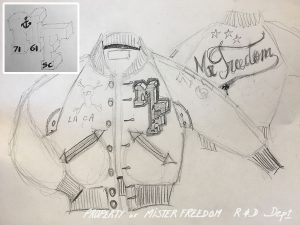 An early original R&D sketch of the MF® HEADQUARTERS jacket ©2018 The MF® HEADQUARTERS jacket is designed in California by Mister Freedom® and manufactured in Japan by Sugar Cane Co and the expert Toyo Enterprise team.
SPECS:
FABRIC:
Body: Olive 36 Oz. yarn-dyed 100% wool, milled in Japan.
Sleeves: Cognac brown genuine horsehide leather.
Sleeve and pocket lining: HBT cotton “Duck Hunter” M1942 reversible camo aka “Frogskin”, milled in Japan.
DETAILS:
* An original mfsc pattern inspired by vintage varsity jackets and early baseball-type jackets.
* Featuring all-original MF® artwork and decoration.
* Genuine horsehide leather sleeves and pocket trims.
* Mil-specs wool knit cuffs and knit collar.
* Old-school arm gusset.
* Unlined body construction featuring attractive taped inside seams, with 1930’s-style narrow-width olive green cotton tape.
* Frogskin camo accents on inner sleeves and slash pocket lining.
* Made in Japan.
SIZING/FIT:
The MF® HEADQUARTERS jacket comes unwashed, and should stay that way. The jacket is ready-to-wear as-is, without any initial protocol. For those familiar with it, the sizing is that of Toyo’s Whitesville stadium jackets. I opted for a size 36 for a trim, balanced fit. The size 38 looked a bit too ‘contemporary’ on me, for my own taste.
Please refer to sizing chart to figure which size will work for you.
CHART
CARE:
If needed, spot cleaning only. Professional cleaning from an eco-friendly facility.
Do not attend to have the whole jacket laundered or dry-cleaned, even from a place that claims to specialize in leather garments. The leather horsehide sleeves can be conditioned after years of wear and exposure to the elements, using professional leather conditioners made for garments (not shoes), such as Pecard products. An attractive natural patina will develop on the sleeves, filled with nicks, stains and character typical of well-worn quality leather garments.
Do not machine wash this jacket!
Available fully-customized.
Sizes
36 Small
38 Medium
40 Large
42 X-Large
44 XX-Large
Available from www.misterfreedom.com, our Los Angeles HQ of course, and fine retailers around the World.
Email sales@misterfreedom.com or call 323-653-2014 with any questions unanswered above.
Thank you for your support.
Christophe Loiron
Mister Freedom®
©2018
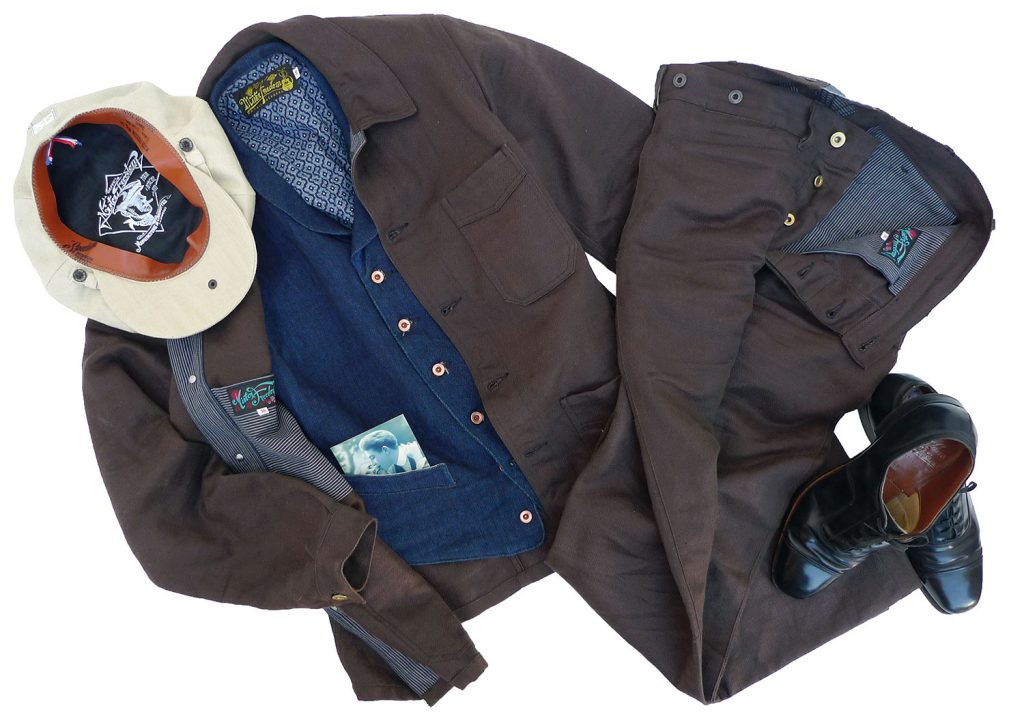
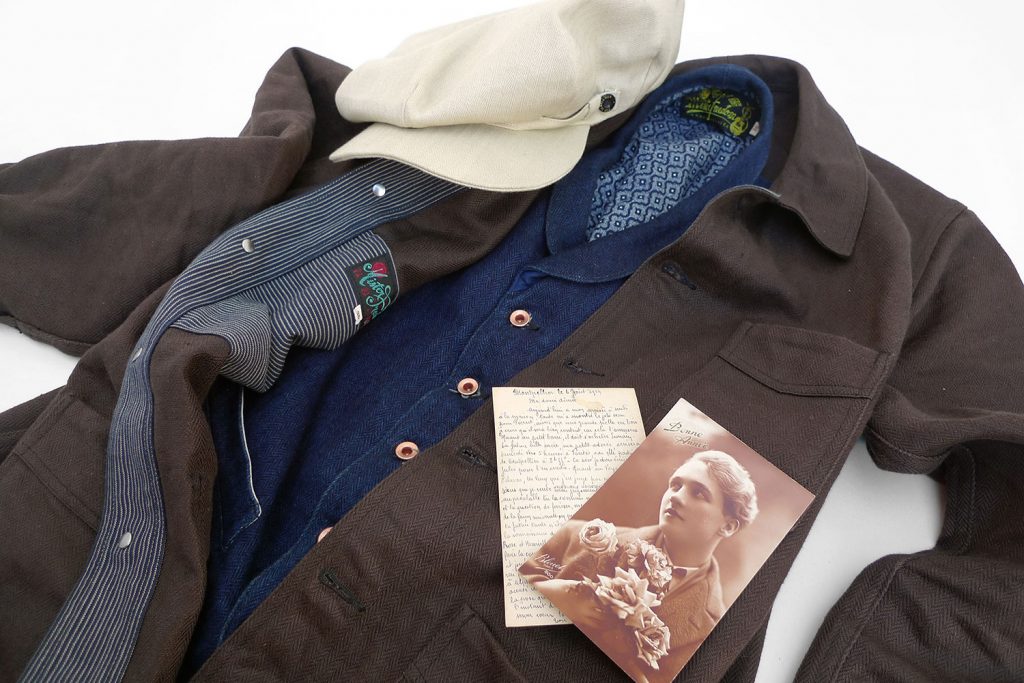
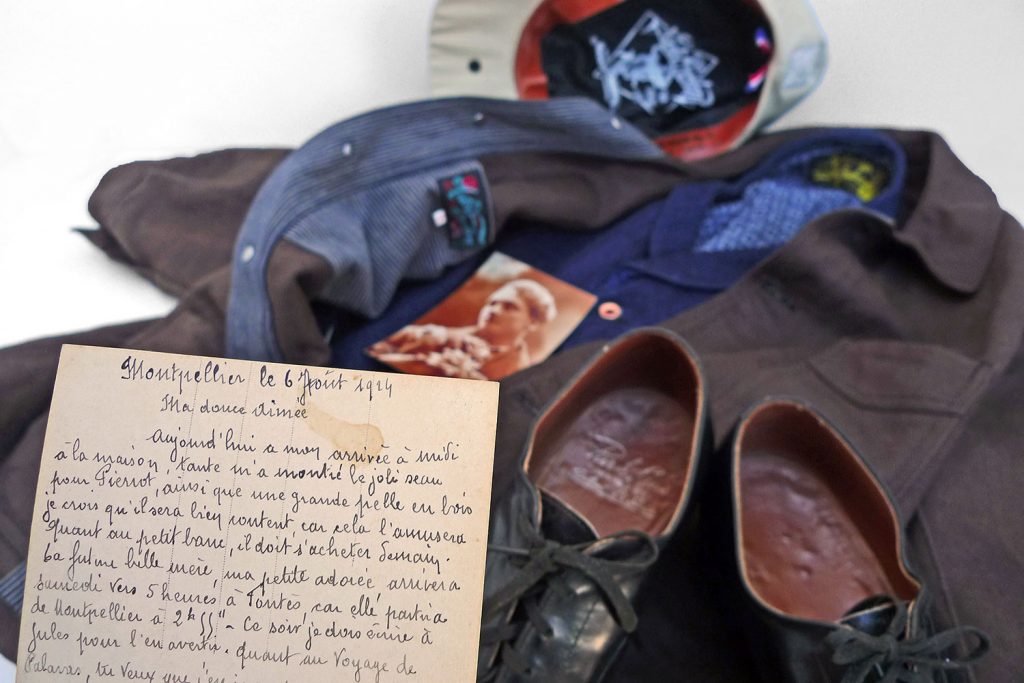

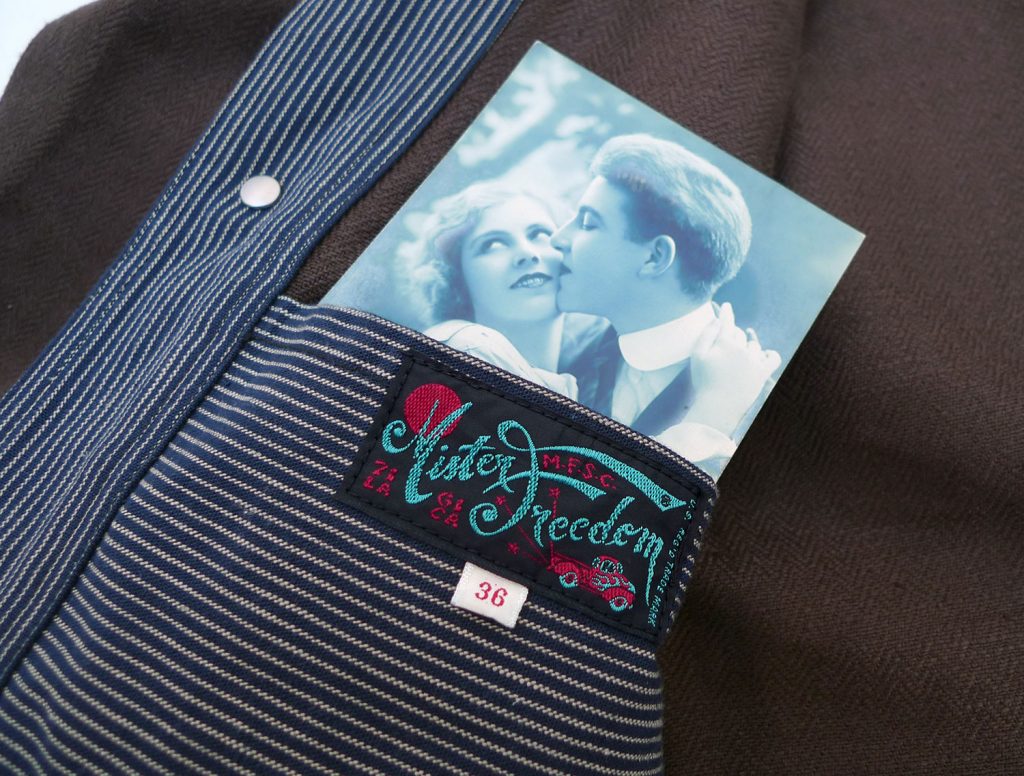
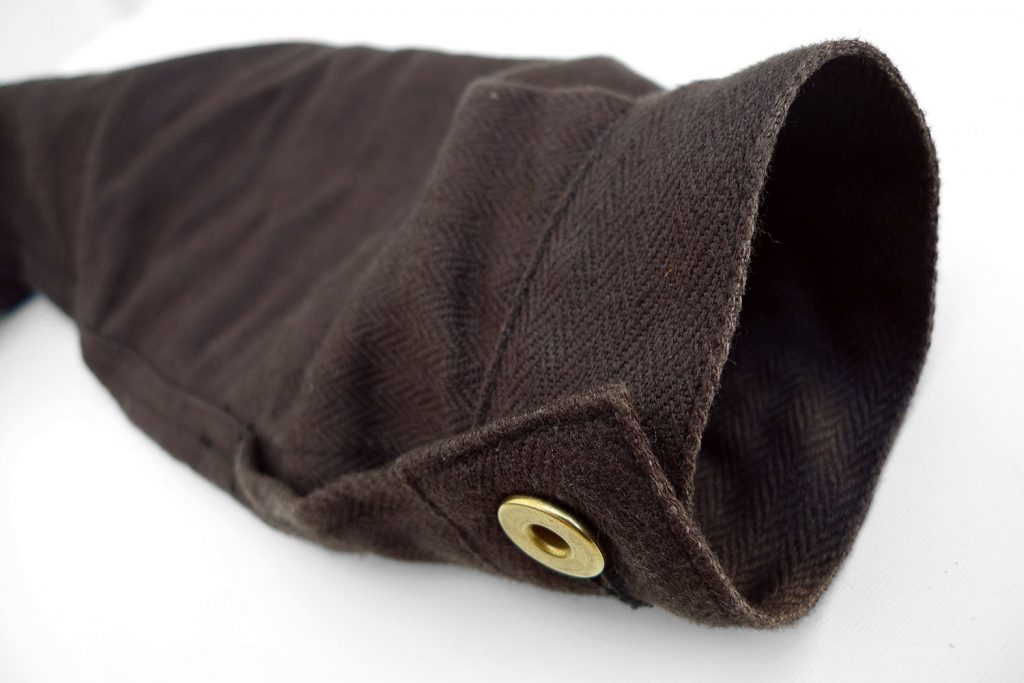
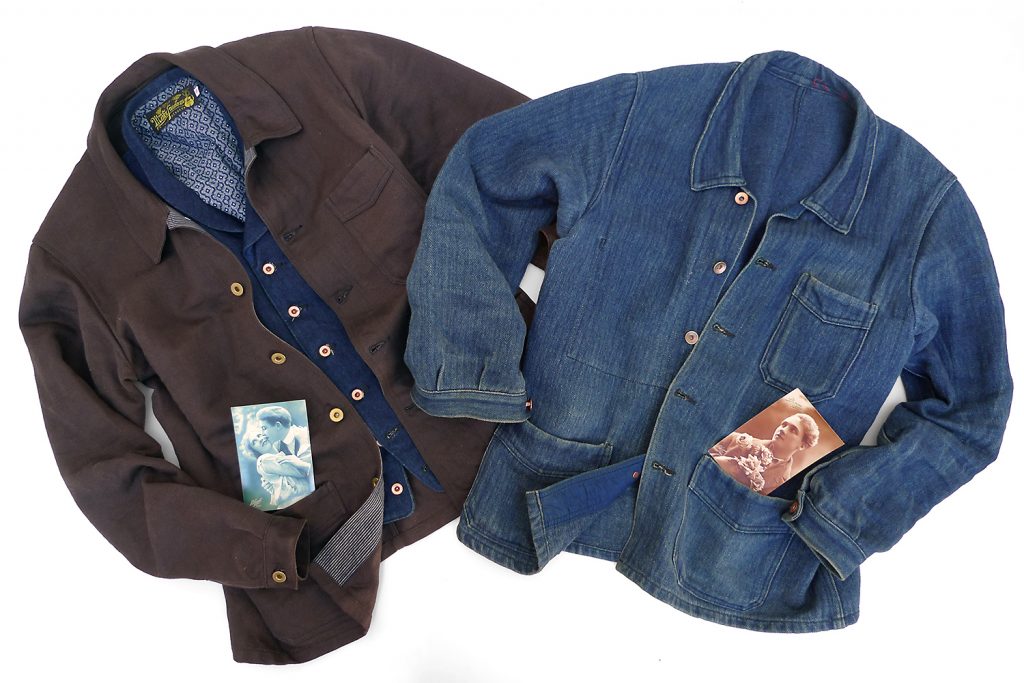 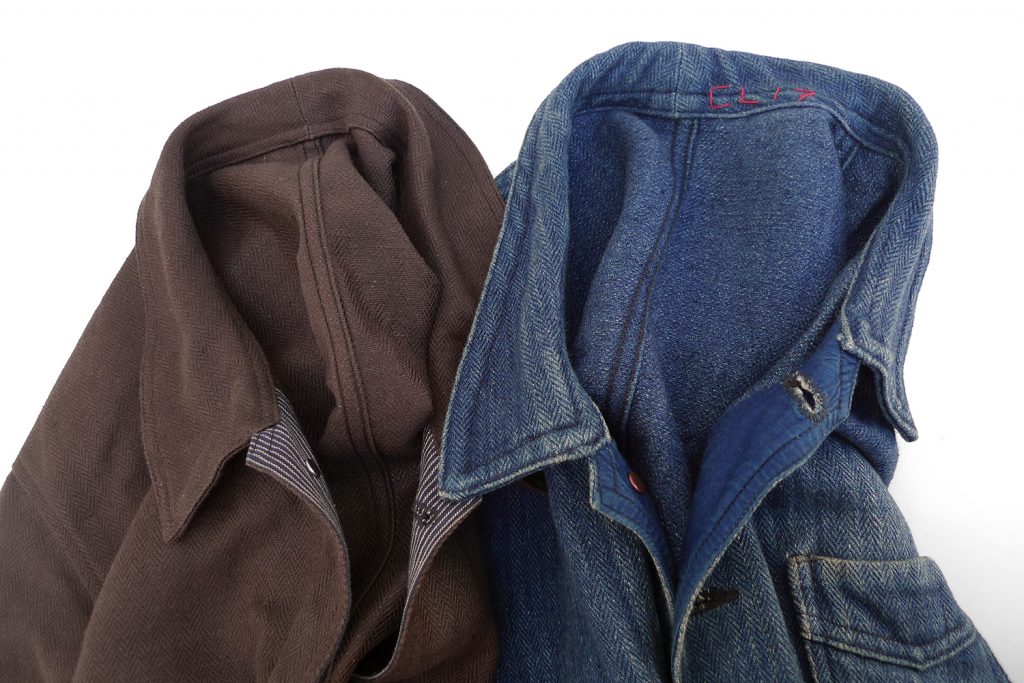
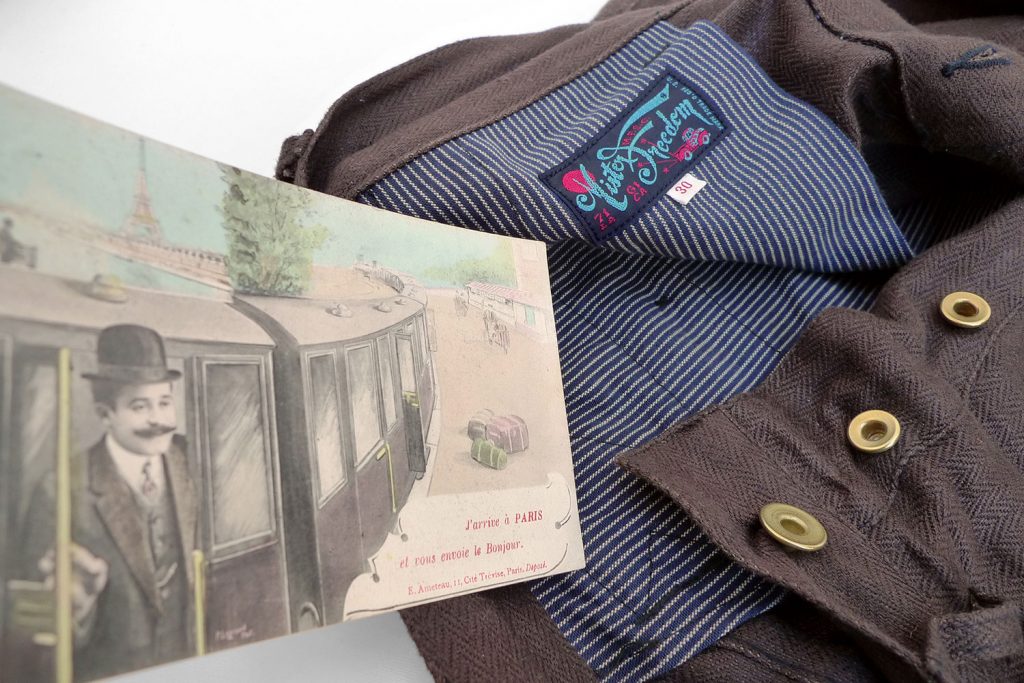 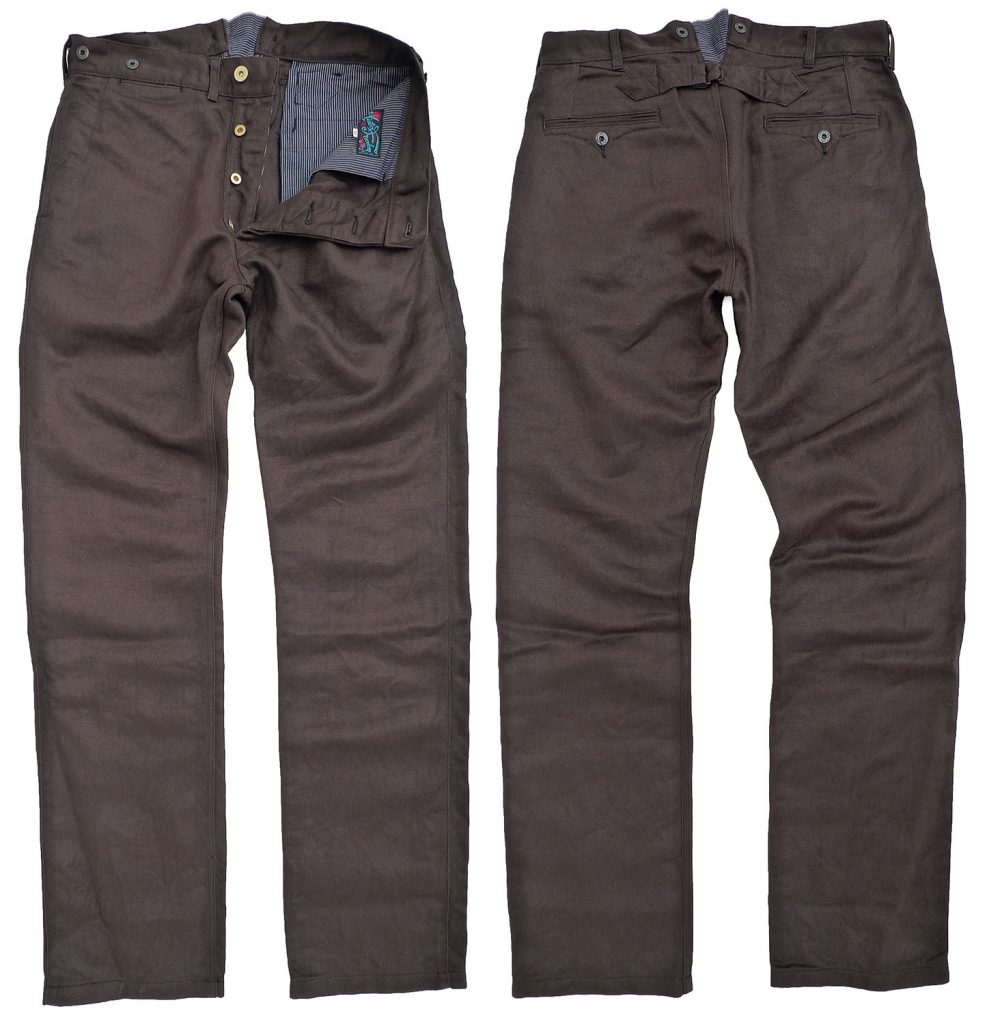
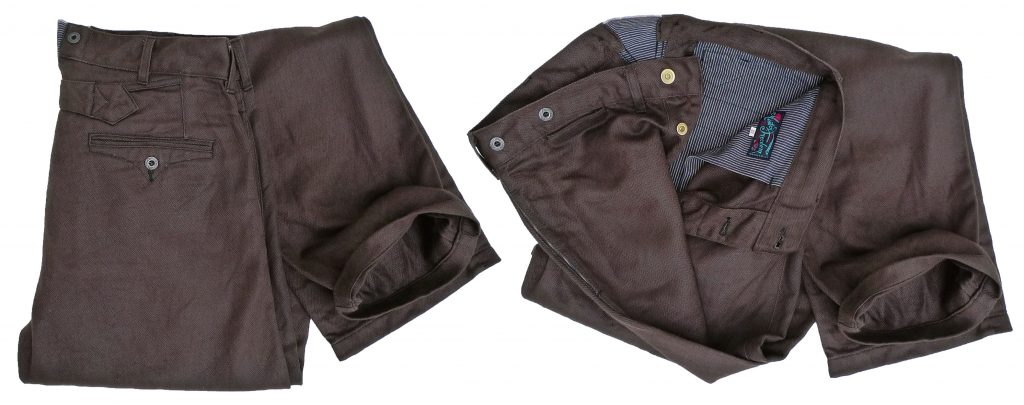
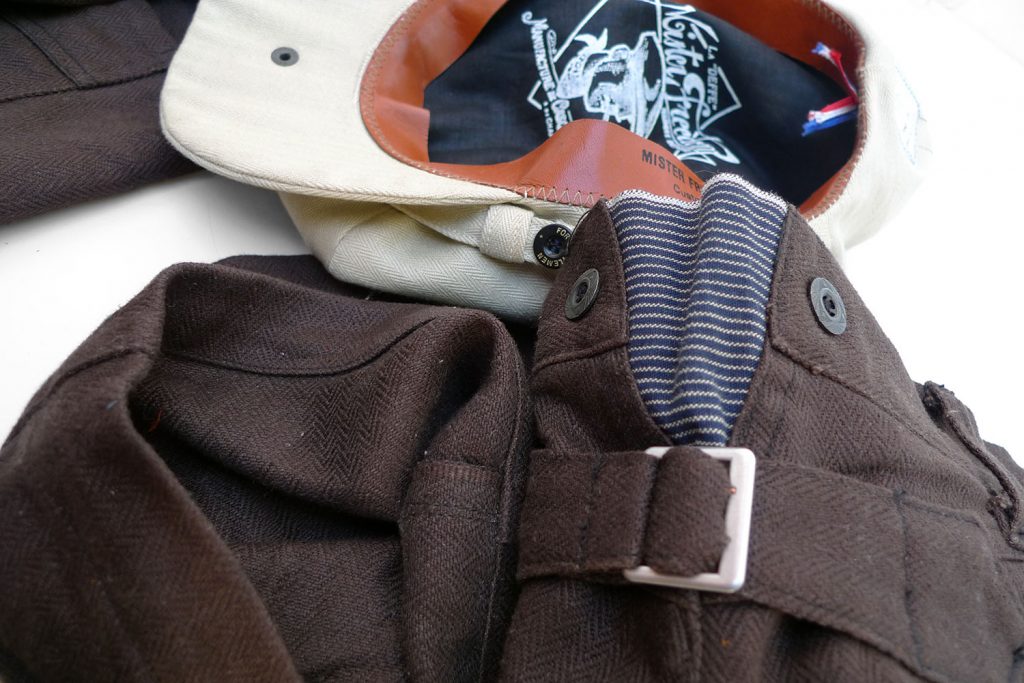
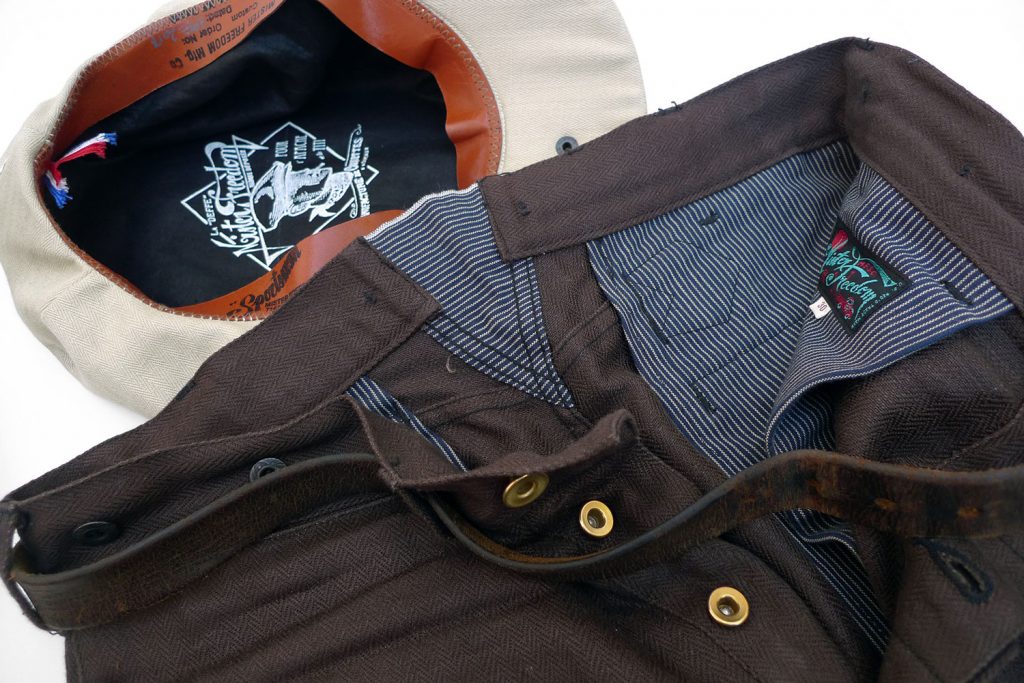
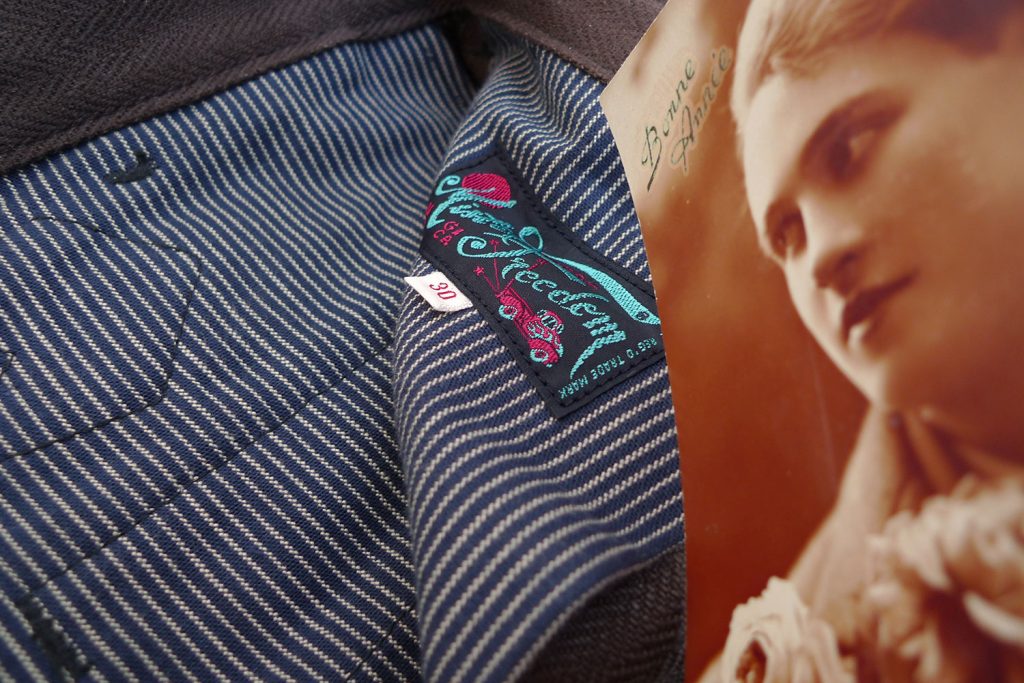
Mister Freedom® “Veste BELLEVILLE” & “Pantalon CAMARGUAIS”, mocha HBT linen/cotton.
FW2018 “Surplus” mfsc collection.
Made in Japan.
We are adding a French twist to the MF® “Surplus” mfsc catalog this season, in the form of two vintage-inspired design classics lifted from the Old World.
The top piece, a classic pattern we reinterpreted and chose to call Veste Belleville, is a style familiar to most today, as it has made it into international streetwear for years. Many modern fashionable versions exist. It is mostly known as the French work jacket, and often referred to as ‘bleu de travail’ (work blues) in its homeland. Our interpretation features the typical two-piece spliced collar, a staple of these French workwear chore coats.
Our Veste Belleville was introduced during the swinging days of our Gypsy Blues escapade, and issued at the time in a covert woven stripe twill, and in a foxy indigo-dyed HBT linen/cotton blend version. That herringbone twill was inspired by vintage French firemen uniforms of the 1900’s. The few rare antique specimen that have survived today are sought-after treasures for designers and militaria collectors alike, both the indigo and black/dark brown versions.
Below, our friend Jérome Girard, aka “J” or “Le Zouave”, fiercely models a 1900’s French Fireman tunic, an authentic early model with an impressive indigo patina. The ‘Nam boonie hat is a nice touch. Photo stolen from J’s epic IG feed.
What a mug, what a legend! Magnifique!
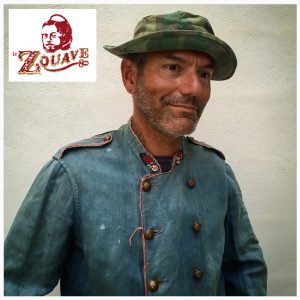
In its un-dyed, loomstate form, our 80% linen-20% cotton blend HBT fabric comes in a natural un-bleached ivory color. It has been featured loomstate on the MF® Waterfront Coat released in 2016.
This season, we decided to offer the same textile in a rich and warm dark brown “mocha” color. Because of the specific method of fabric-dyeing we opted for, the core of the yarn keeps its original off-white color, a telltale of future attractive patina.
Now the pants. The bottom piece is also a classic European garment pattern we reinterpreted, a traditional 1900’s-1930’s style of French work pants popular with farmers and laborers. We decided to name this pattern “Pantalon Camarguais” because of the twist we put on it.
Pronounced KA-MAR-GAY (the u is silent), the adjective is a reference to a French region called Camargue. For those unfamiliar with this beautiful corner of the world, we mentioned it briefly while introducing the Gilet Gadjo of the 2017 Gypsy Blues collection.
“ … If black and navy blue are typical colors of old-school French workwear, brown and cream moleskin garments were quite popular with the Gardians of Camargue, the gritty Provençal cowboys dreamed-up by the legendary Old-West-obsessed Folco de Baroncelli in the early 1900’s. In the old days, these famed horsemen of the delta of the Rhone, Southern France, typically wore moleskine boot-cut riding pants, with the characteristic contrast piping running down the leg seam. A matching moleskin vest, flamboyant plaid or printed cotton shirt, low-crown western-style hat, and a pair of Camarguaises (local traditional rough-out leather boots) often completed these work outfits.
(For the commun thread between Gardians and our Gypsy Blues story, Camargue’s most iconic commune is Saintes-Marie-de-la-Mer, a notorious annual pilgrimage destination for Gypsies coming from the four corners of Europe.) “
The Provence cowboy connoisseur will note that our “Camarguais” pattern is a blend of vintage style references, but absolutely not a replica of the typical French Gardians’ riding trousers mentioned above. As admirative and respectful of Costume History as we are, we took some liberties with authenticity on this one. One of our inspirational piece for the project, the vintage super-high-waisted blue moleskine pantalon pictured below, was re-worked into a 21rst Century wearable, sans the charming albeit ill-fitting and costumey vibe of the original. The back rise reaching the shoulder blades is a bit hard to pull-off these days.
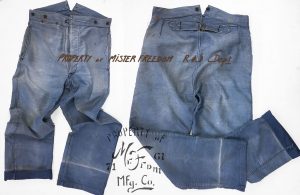
The pocketing we opted for, for both jacket and pants, will look familiar to the ol’ MF® OG: it was featured ages ago on our Pantalon Ouvrier. This sturdy indigo stripe ticking fabric was also inspired by antique French textiles.
Voila!
Pair these fine pieces as a set and call it le French leisure suit, or incorporate either for a touch of rugged Old World elegance in your wardrobe, the Veste Belleville and Pantalon Camarguais are now part of the Mister Freedom® SURPLUS collection of international classics, made for the discerning Gentleman of style concerned with ethical manufacturing.
The MF® “Veste BELLEVILLE” & “Pantalon CAMARGUAIS” are designed in California by Mister Freedom® and manufactured in Japan by Sugar Cane Co and the expert Toyo Enterprise team.
SPECS:
FABRIC:
A fancy 15 Oz. blend of 80% linen and 20% cotton Herringbone Twill (HBT), dyed in small batches in a warm mocha brown color, keeping the core of the yarn natural. Selvedge fabric, expertly milled and dyed in Japan.
Lining and pocketing: 8 oz. indigo/white warp and black weft striped twill, fine herringbone weave, white selvedge, un-sanforized (respectfully lifted from a late 1800′s swatch of french workwear textile)
1) MF® Veste BELLEVILLE, mocha HBT.
DETAILS:
* Inspired by classic 1930’s-40’s traditional French work/farmer jackets.
* Utilitarian unmarked ‘donut’ brass metal buttons.
* Three outside patch pockets. Elongated chest pocket fits some iPhone models.
* Concealed chest pocket, featuring the MF® “SURPLUS” woven label.
* Contrast indigo stripe ticking button placket facing.
* Early tailoring off-set shoulder seam pattern.
* Arms mounted with piping method, indigo-dyed tape.
* Flat-felled seam construction, hi-count tonal stitching.
* Made in Japan.
SIZING/FIT:
The MF® Veste BELLEVILLE, mocha HBT comes raw/unwashed, and will shrink to tagged size.
Follow the usual recommended initial method before wearing: cold soak for 30mn, occasional hand agitation, spin dry and line dry.
We recommend sizing down on MF® Veste BELLEVILLE in mocha HBT, as we had advised for both the indigo and covert original versions. I usually wear 38 (Medium) in mfsc jackets, but went with a 36 (small) with the Belleville, without arm-hole issues.
Please refer to chart to figure which size works for you. If still confused, email sales@misterfreedom.com
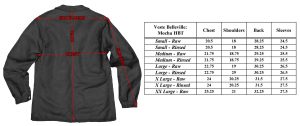
Available raw/unwashed.
Sizes
36 Small
38 Medium
40 Large
42 X-Large
44 XX-Large
1) MF® Pantalon CAMARGUAIS, mocha HBT.
DETAILS:
* An original mfsc pattern inspired by vintage French farmer/laborer work pants and 1900’s European trousers.
* Cinch-back with vintage-style steel/copper combo sharp prong buckle.
* “French seam” style outseam, featuring the HBT fabric selvedge ID.
* Early French trousers style back yoke.
* Rear expansion gusset featuring the indigo ticking pocketing fabric ID selvedge.
* Slim beltloops.
* Utilitarian unmarked ‘donut’ brass metal buttons.
* Arcuate stitch design on pocket openings.
* Rear gusset featuring the indigo ticking pocketing fabric ID selvedge.
* Art Deco-style sheet metal suspender buttons.
* Flat-felled seam construction, hi-count tonal stitching.
* Made in Japan.
SIZING/FIT:
The MF® Pantalon Camarguais, mocha HBT comes raw/unwashed, and will shrink to tagged size.
Follow the usual recommended initial method before wearing: cold soak for 30mn, occasional hand agitation, spin dry and line dry.
These trousers feature a quite generous cut. I opted to size down to a Waist 30, for a slimmer silhouette.
Please refer to chart to figure which size works for you.
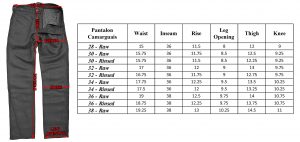
Available raw/unwashed.
Sizes
W28 x L36
W30 x L36
W32 x L36
W34 x L36
W36 x L38
W38 x L38
CARE:
Hand wash or machine wash on delicate, cold water, minimal eco-friendly detergent. Turn inside-out to avoid marbling of the fabric. Line dry ONLY.
This fabric will develop attractive patina overtime, according to the owner’s activities, frequency of wear and laundering choices.
Available from www.misterfreedom.com, our Los Angeles HQ, and fine retailers around the World.
Email sales@misterfreedom.com or call 323-653-2014 with any questions unanswered above.
Thank you for your support.
Christophe Loiron
Mister Freedom®
©2018
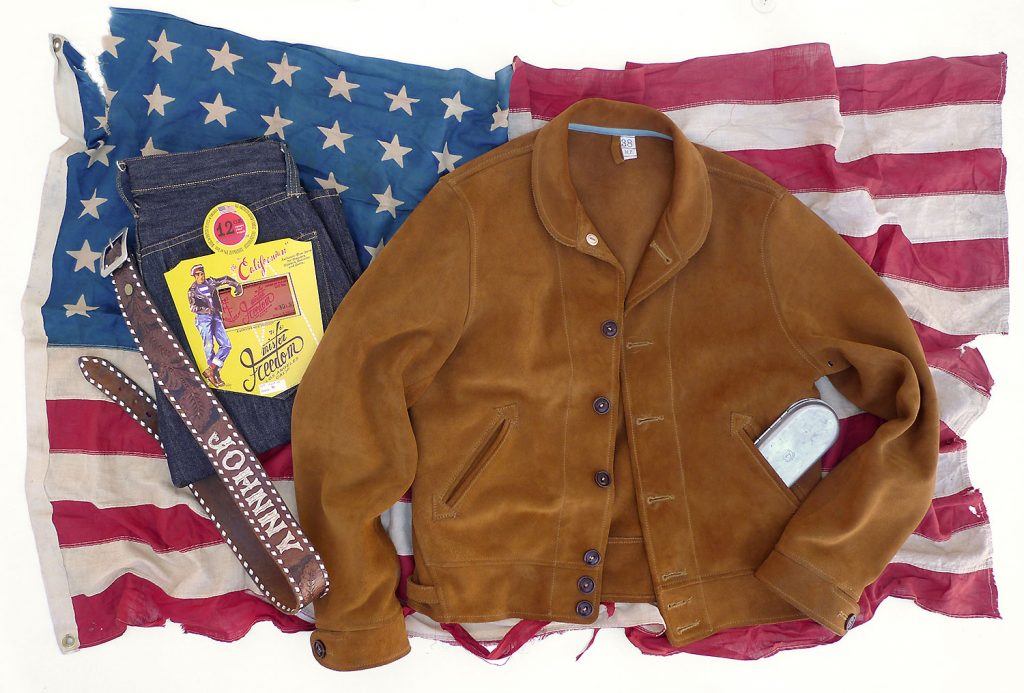

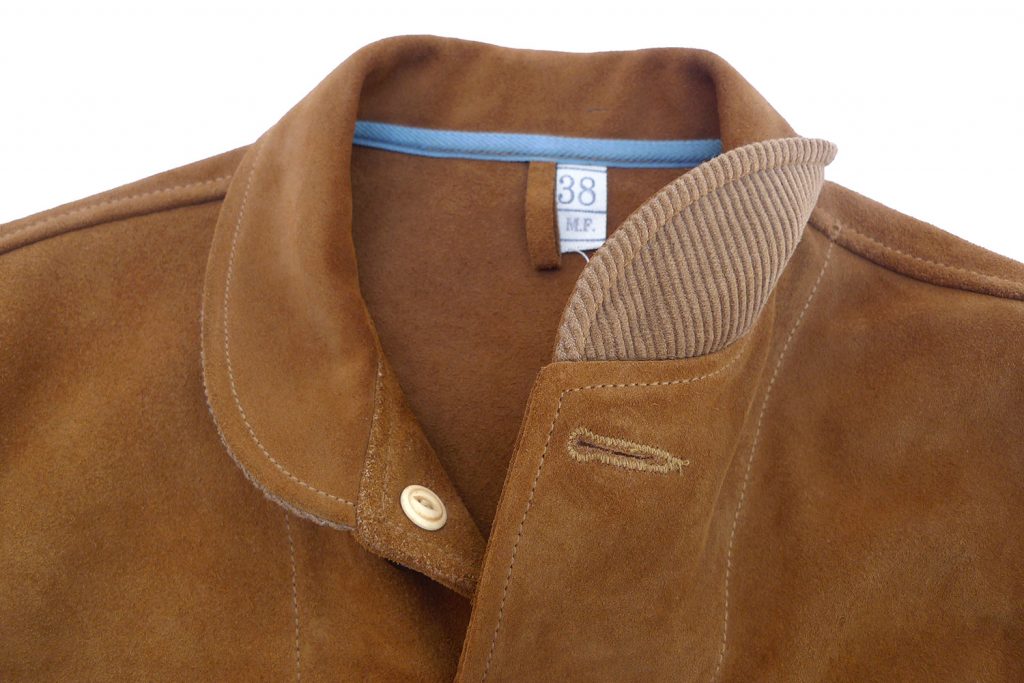
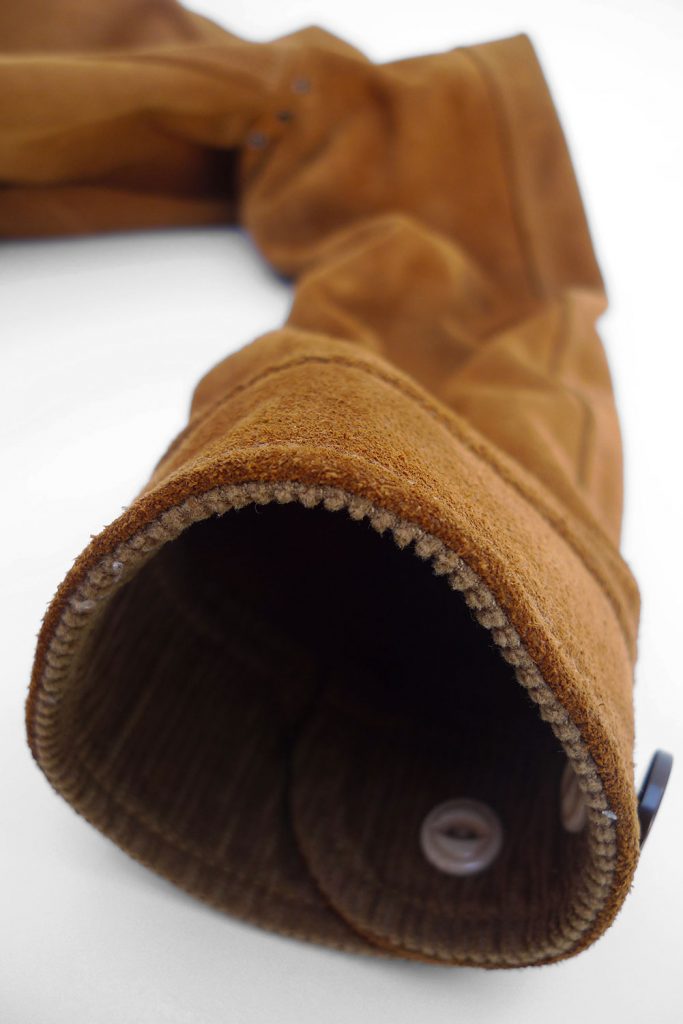
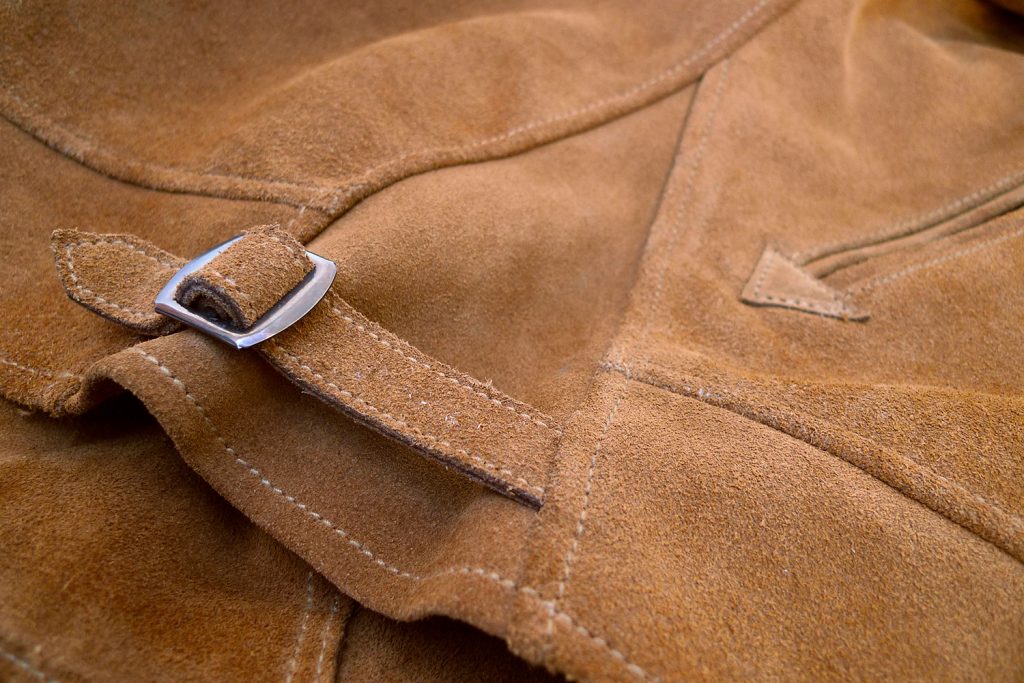
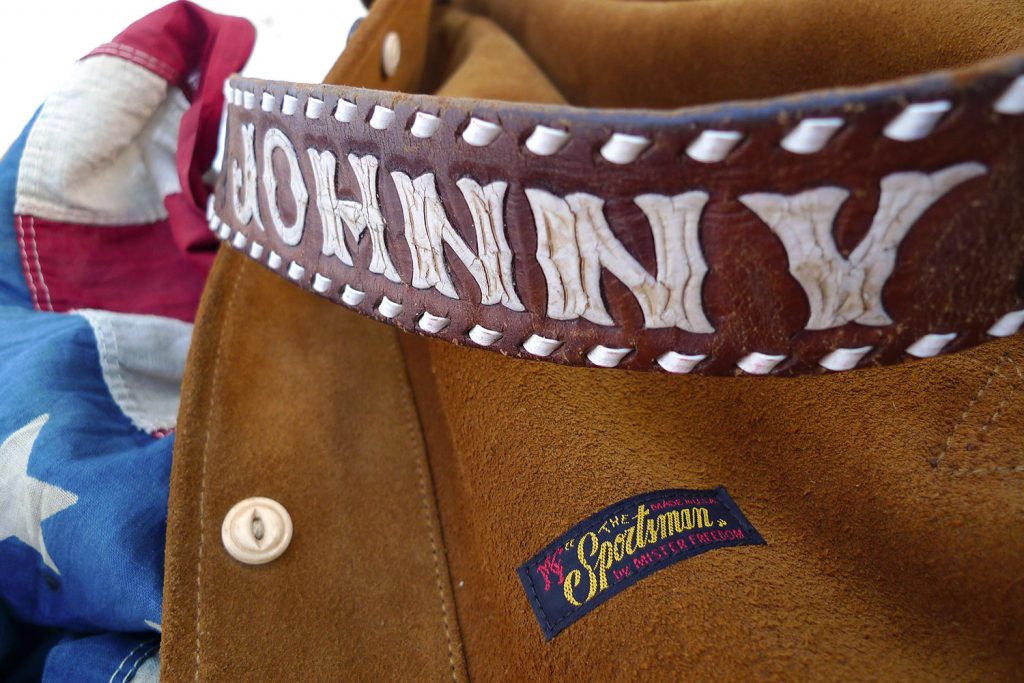
 McQueen being McQueen, 1961 (photo Larry Barbier Jr., courtesy of Getty Images) Mister Freedom® “JOHNNY” Campus jacket, cognac suede cattlehide.
Fall 2018 mfsc Sportsman catalog.
Made in USA.
Our popular MF® Campus pattern is back this Fall, this time in a vibrant suede cow-split leather.
For those who wonder, the name is a quaint reference to the 1991 flick “Johnny Suede”, which I watched some twenty-five years ago, and can’t remember the first thing about, besides the catchy title and Brad Pitt’s big hair.
While out shopping for hides from local suppliers, we selected this particular leather not just for its convincing vintage orange-brown color, a rich cognac tone reminiscent of classic 40’s-50’s suede sportswear jackets, but also because of its durable quality feel, as this is a leather grade used to make western riding chaps. For those eagerly awaiting Mister Freedom® leather chaps, the wait is not yet over.
As its veg-tan cowhide Campus predecessor, initially introduced in 2013 and still produced today in the USA, the MF® “JOHNNY” is unlined. Not a way to save on lining fabric, but rather a nod to unlined “Cossack” leather sports coat models popular in the 1930’s, and a real challenge construction-wise when striving to keep clean seams inside & out.
If the Veg-tan cowhide MF® Campus really takes on a new dimension and beautifies over time (according to the owner’s activity, leather expertise, frequency of wear, conditioning choices and patina preference), the JOHNNY is good-to-go from the get-go.
We do not recommend any initial special spraying or conditioning to make the garment weather-proof or stain-repellent. We have not tested anything really convincing on suede, most treatments will result in an irreversible darkening of the suede leather, and shoe products should definitely not be used on a sport jacket… The old standard practice of dubbing roughout service boots in the military (see tips from our friend Mosquito_Boat) doesn’t apply here.
We believe that our “JOHNNY” Campus has its own dress-up feel, and will benefit from being kept ‘clean’ to age gracefully. The desirable rugged attitude of its Veg-Tan cowhide counterpart properly-worn and conditioned (see the amazing results on Vintage_Engineer_Boots‘ own Campus jacket, with the whole process detailed here) may not work with this suede leather release.
We might be proven wrong and come across a beat-up “JOHNNY” specimen with killer natural patina in a few years (keep an eye on the ultra-talented artist Mark Maggiori‘s IG), but until then, understand that it’s the nature of a casual suede leather sport jacket to be vulnerable to the elements, and Ketchup®. Please wear and feast accordingly.
-
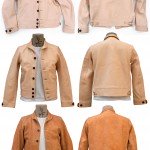
-
The rugged MF® Veg-Tan Campus jacket initially released in 2013.
-
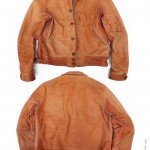
-
Perso Campus jacket, after 1.5 year of intermittent wear
The MF® “JOHNNY” Campus in suede cattlehide is designed and made in California by Mister Freedom®.
SPECS:
PATTERN: An original pattern inspired by 1930’s sportswear type lightweight and unlined leather jackets.
LEATHER: Durable and supple suede cattlehide with a soft nap, aka cow-split leather, a grade used to make western riding chaps. Cognac color.
DETAILS:
* 1930’s silhouette
* One piece back
* Fully unlined, clean seams inside & out.
* Cotton corduroy collar and wrist cuff facing
* Slash pockets with arrowhead-shaped edges.
* Side gussets with adjustable side straps (NOS metal slide buckles)
* Keyhole button holes.
* Brown ‘Cat-Eyes’ corozo wood buttons (aka ivory nut), backed by contrasting ivory-color corozo support buttons.
* Underarm venting eyelets
* Mister Freedom® ‘The Sportsman’ woven label behind the slash pocket, right front panel.
* High stitch-count, sturdy poly-cotton thread stitching.
* Made in California, USA.
SIZING/FIT:
The MF® “JOHNNY” Campus Jacket does not require any type of pre-treatment or conditioning and is ready to wear as-is. This garment is cut quite slim but is considered true-to-size.
I wear a slim-fitting size 38 in the “JOHNNY” Campus Jacket, my usual size in mfsc jackets. Keep in mind that we are referring to a classic old-school type fit, not a contemporary streetwear silhouette.
Please refer to approximate measurement in chart below.
CHART
CARE:
This is quite a delicate jacket, not intended to be worn while working in the field but rather as a dress-up garment.
It does not require any type of pre-treatment and is ready to wear as-is. Cleaning should be left-up to your local professional leather cleaning environmentally-friendly facility.
DISCLAIMER: Due to the unlined quality of this jacket, some staining of a garment worn under or over might occur. Please consider that color transfer on a light color shirt might be challenging to remove with regular laundry methods.
Available sizes:
36 (Small)
38 (Medium)
40 (Large)
42 (XLarge)
44 (XXLarge)
Available from www.misterfreedom.com , from our funky brick and mortar store in Hollywood, CA., and from a few selected fine boutiques around the World.
Please call 323-653-2014 or email sales@misterfreedom.com with any questions not answered above. And no, it doesn’t come in black.
Thank you for your support.
Christophe Loiron
Mister Freedom®
©2018
|







